EXPEDITIONS:
Impala antelope rutting behaviour
Expedition to impala habitats. Namibia, May 2015.
Participants: Volodin I.A., Volodina E.V., Frey R.
Funded Russian Foundation for Basic Research (RFBR, grant 15-04-06241) and Russian Science Foundation (RSF, grant 14-14-00237).
Why impala are interesting so much that we came to Africa?
Presence of speech is one of the most important differences between humans and non-human mammals. Our ability to articulate speech is predeterminated by a low position of the human larynx, distinctive to those of any other primate species. So far is unknown, when the larynx descent has occurred in human evolutionary history. We do not know, which evolutionary factors «forced» the human larynx to descend and which advantages human ancestors obtained from the lowered larynx compared to their congeners. Paleontology cannot answer this question. However, we can ask the extant animals with human-like position of the larynx, such as impala antelope.
In a few species of ungulates including impala, the low position of the larynx is reminiscent of the situation of humans. In addition, their larynges can be retracted by special muscles along the neck down up to the sternum. This retraction results in lowering vocal tract resonances (formants). The resulting acoustic effect allows the animals to acoustically exaggerate own body size as if they are larger than in reality. To date, the retraction of the larynx was found during the rut only in red deer stags (Reby, McComb, 2003; Frey et al., 2012 187.pdf), fallow deer bucks (McElligott et al., 2006), male Mongolian gazelles (Frey et al., 2008) and male goitred gazelles (Frey et al., 2011 182.pdf). Rutting impala males also retract the larynx during their rutting calls. However, details of this behaviour had not yet been investigated.
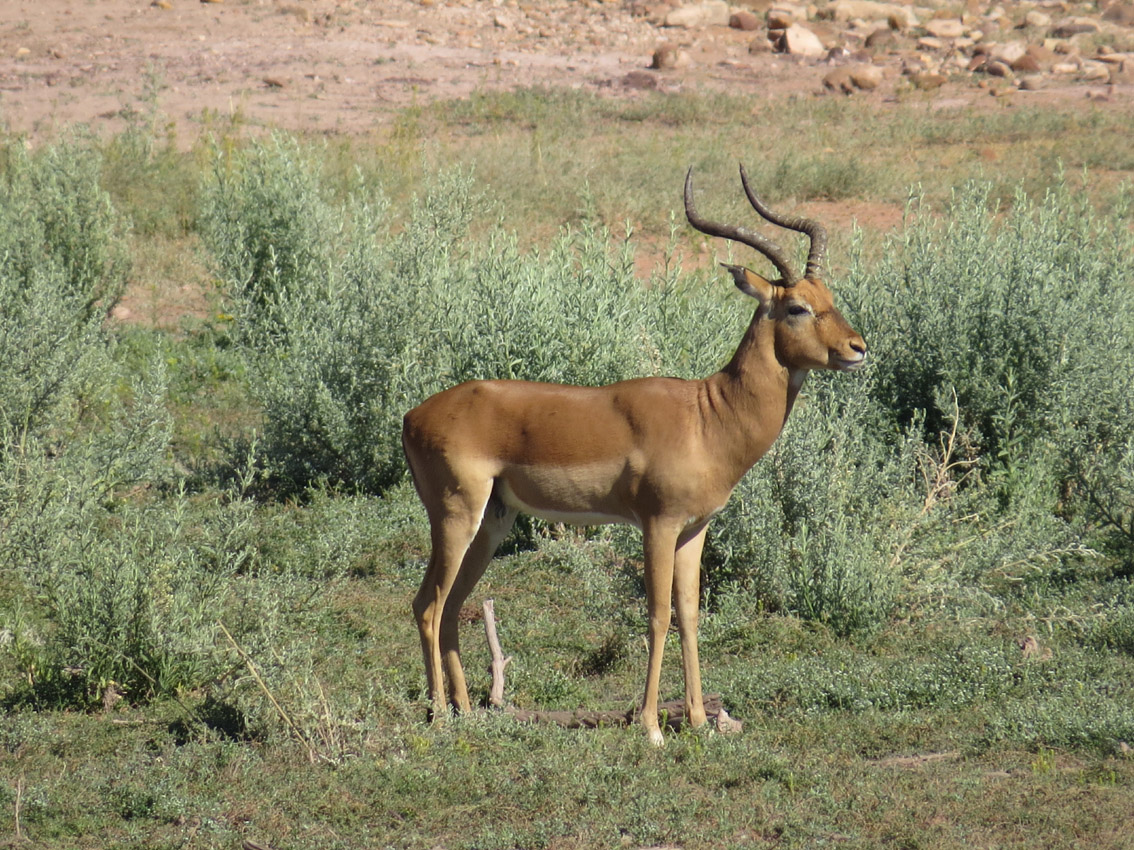
1. Impala male.
Knowledge about impala reproductive behaviour is poor. There is only scarce information that rutting impala males compete for females displaying expressive movemental and vocal behaviour. This behaviour can be observed in zoos, although very rarely.
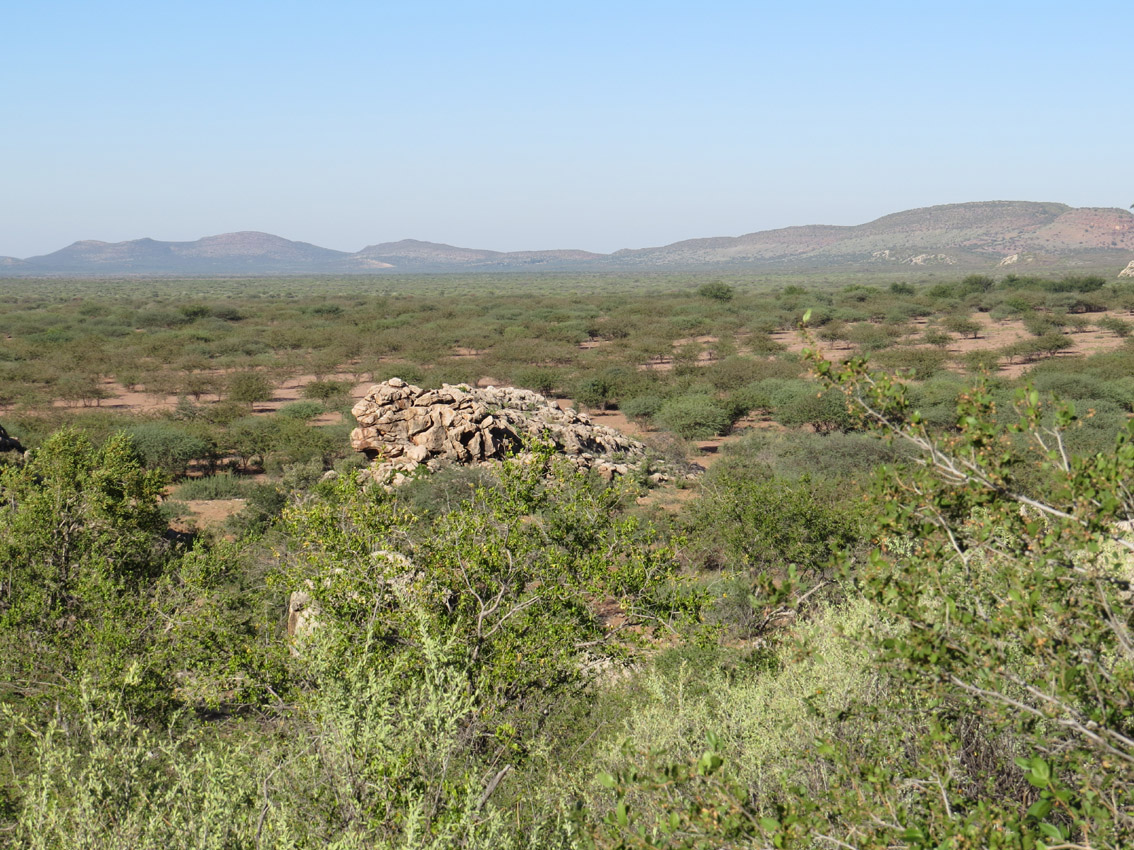
2. Namibian plain panorama
To study rutting behaviour of impala, we went to central Namibia. The Namibian plateau with small rocks there and then is elevated by 1500 m above the sea level. The plain is covered by savanna but near the rocks, the trees are changed with dense spiny bush. Most of the territory of Namibia is taken by private cattle and safari farms.
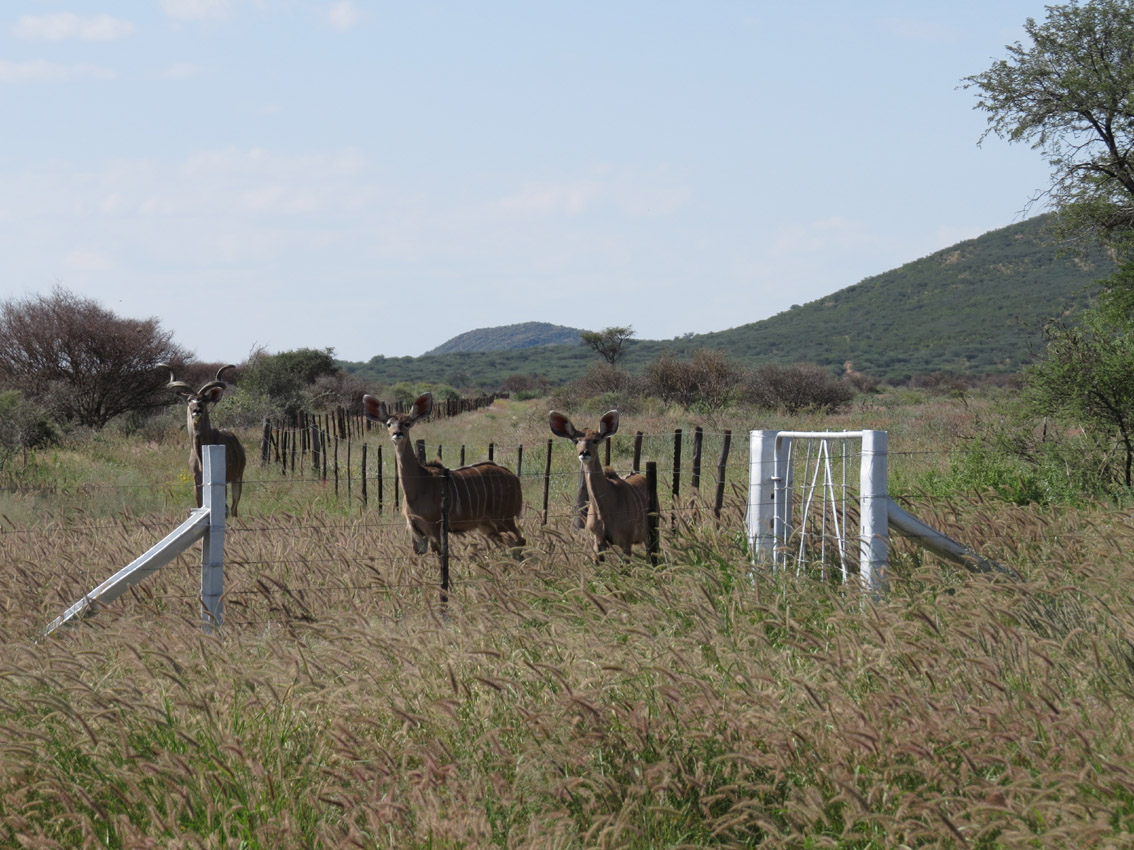
3. Safari-farm.
In the last dozen years some farmers started keeping wild African ungulates instead of the cattle. These farms are fenced with high fences and represent safari-farms or private reserves. The presence of ungulates attracts cheetahs, leopards and brown hyenas. Unlike the owners of cattle ranchos, the owners of safari-farms do not chase these predators.
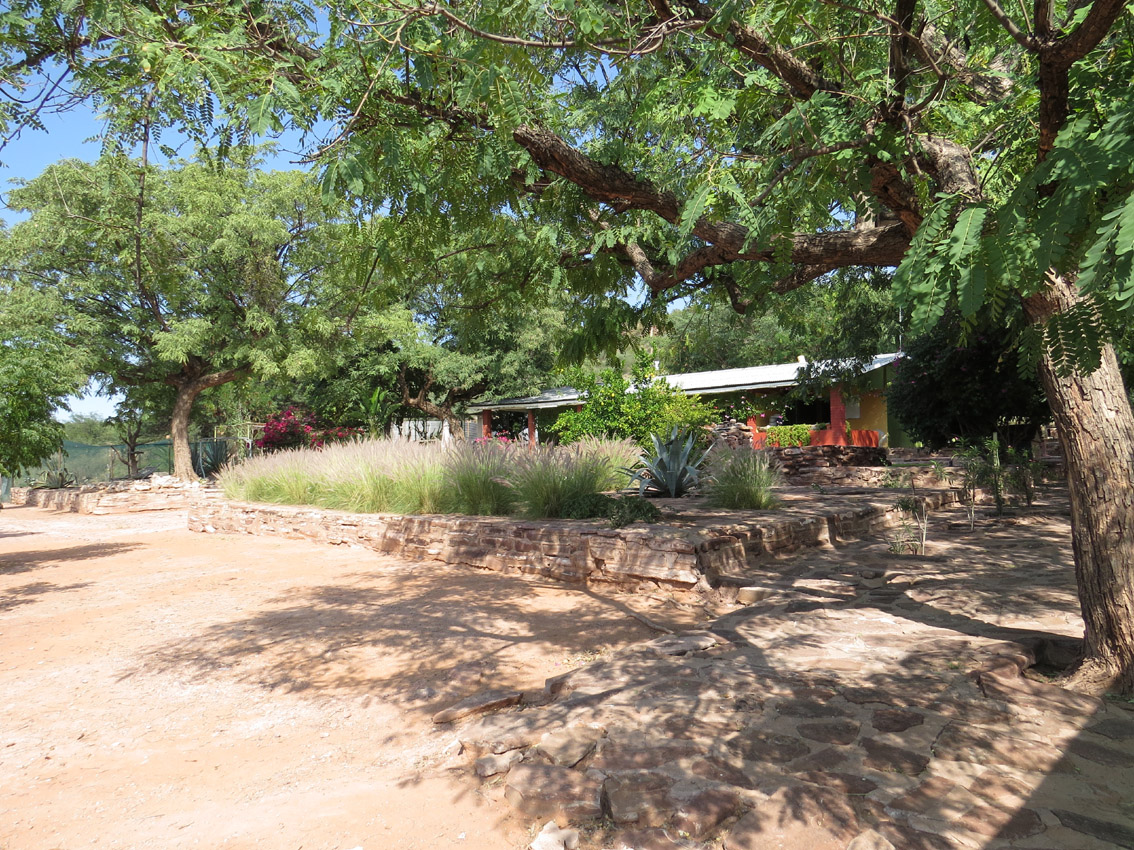
4. The field station of the Institute for Zoo and Wildlife Research (IZW-Berlin) on the Okambara safari-farm.
We worked at the safari-farm Okambara. The field station of the Institute for Zoo and Wildlife Research (IZW-Berlin) was rented by the IZW from the farm owners primarily for investigation of cheetahs, leopards and brown hyenas, inhabiting agricultural and safari-farms of Namibia. These predators hunt also impala antelopes. To Okambara farm, fifty impalas were introduced twenty five years ago. Now, there are about eight hundred individuals at the Okambara farm.
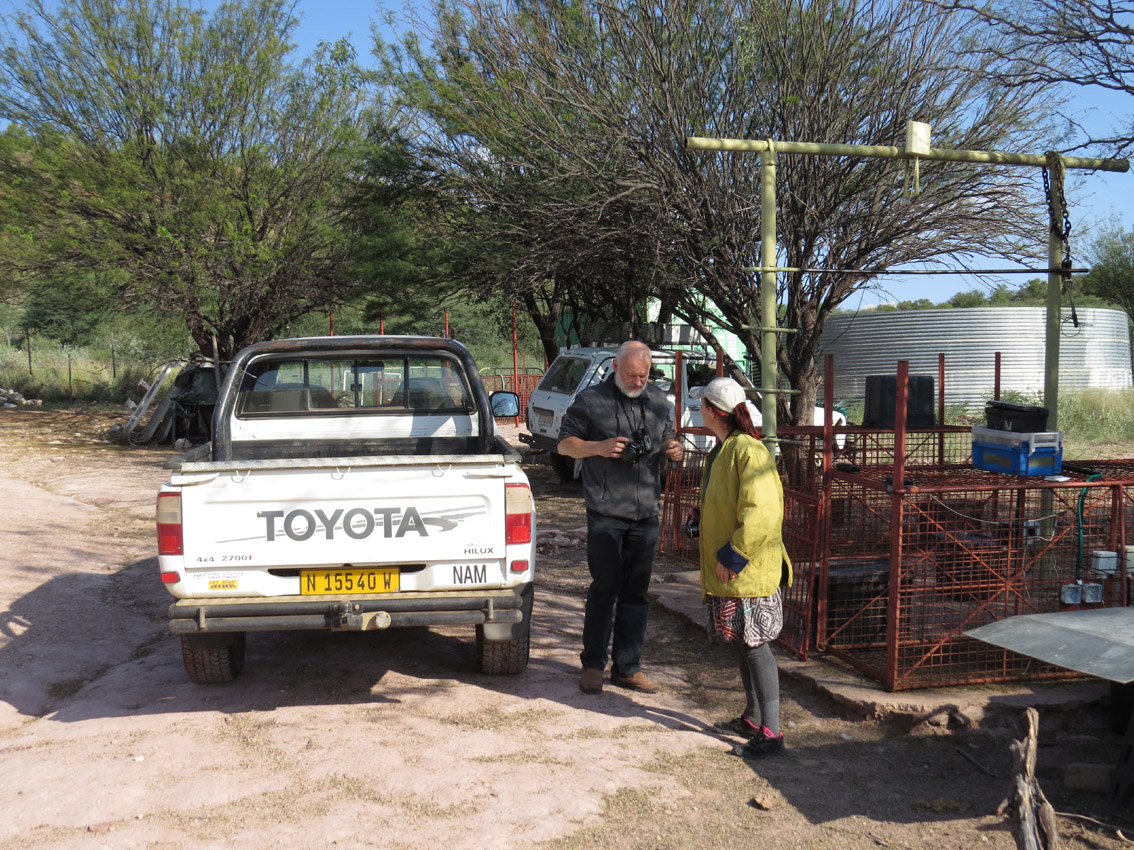
5. Traps for large predators.
For capturing cheetahs, leopards and brown hyenas, researchers use live-traps with photo-elements (on the photo, they are to the right). The live trap is so large, that a car can transport only one. When the trap captures an animal, it sends SMS and a photo of it to researchers. If the animal is the cheetah, leopard or brown hyena, the researchers immediately depart to it for taking biological samples and putting a radio electronic collar on the animal. If the trap captured an unnecessary animal as a warthog or a black-backed jackal, the researchers do not go there but just phone to the farm owners asking to open the trap and to release the animal.
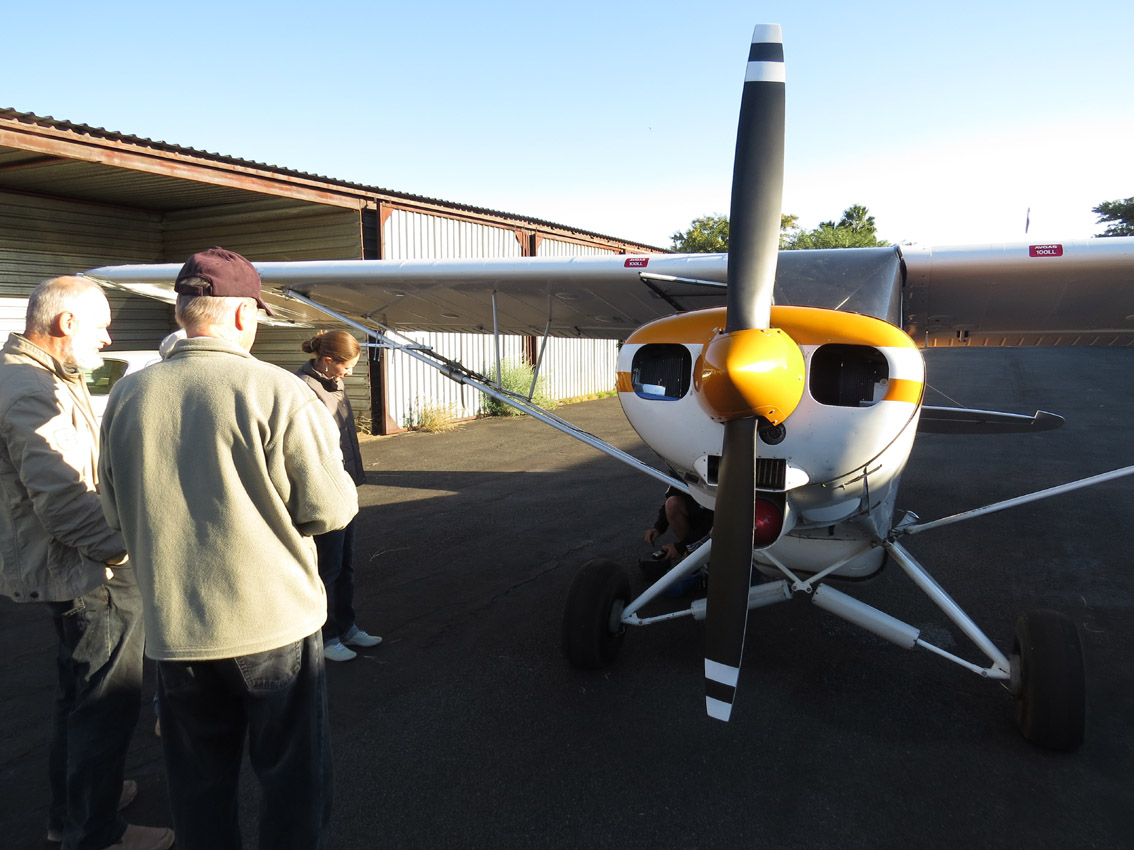
6. The airplane of small aviation.
For tracking the cheetahs, leopards and hyenas, researchers rent a small plane with a pilot. Once a week, one member of the research team flies for six hours for radio tracking the large carnivores labeled with the electronic collars. This method helped to investigate the cheetah hunting territories and to confirm that they are much larger than thought previously.
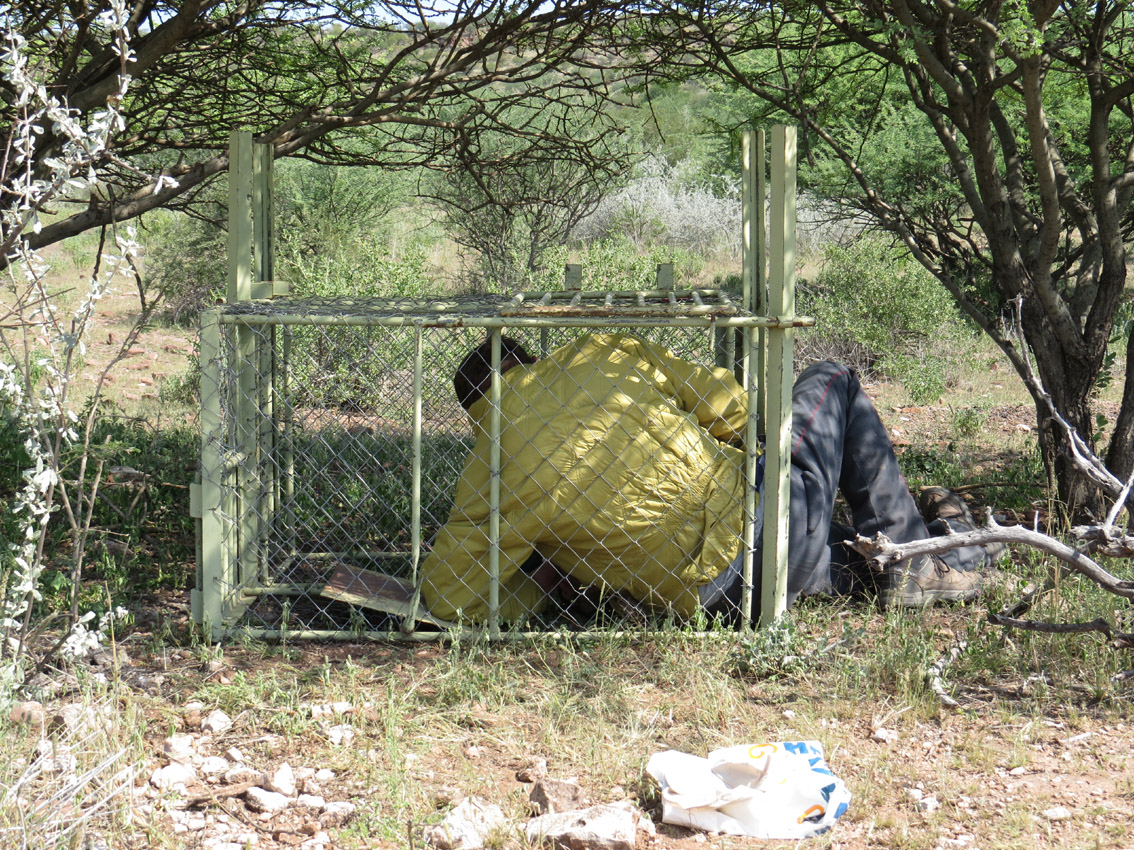
7. Placing a songmeter in an idle cheetah cub trap.
Impala inhabit dense bush, where seeing them is not so easy. So, automated sound recording (songmeters) play an important role for collecting the male impala rutting calls. The songmeters work autonomously without the presence of researchers, by a pre-set schedule. At onset of impala rut period, we scheduled the songmeters for working only in the morning and in the evening. But during the most active rut males called for 24 hours, so songmeters were re-programmed to work for nearly all day and night. We embedded the songmeters in cages to protect them against curious baboons, which may unscrew in two ticks any unit to which their playful paws can reach.
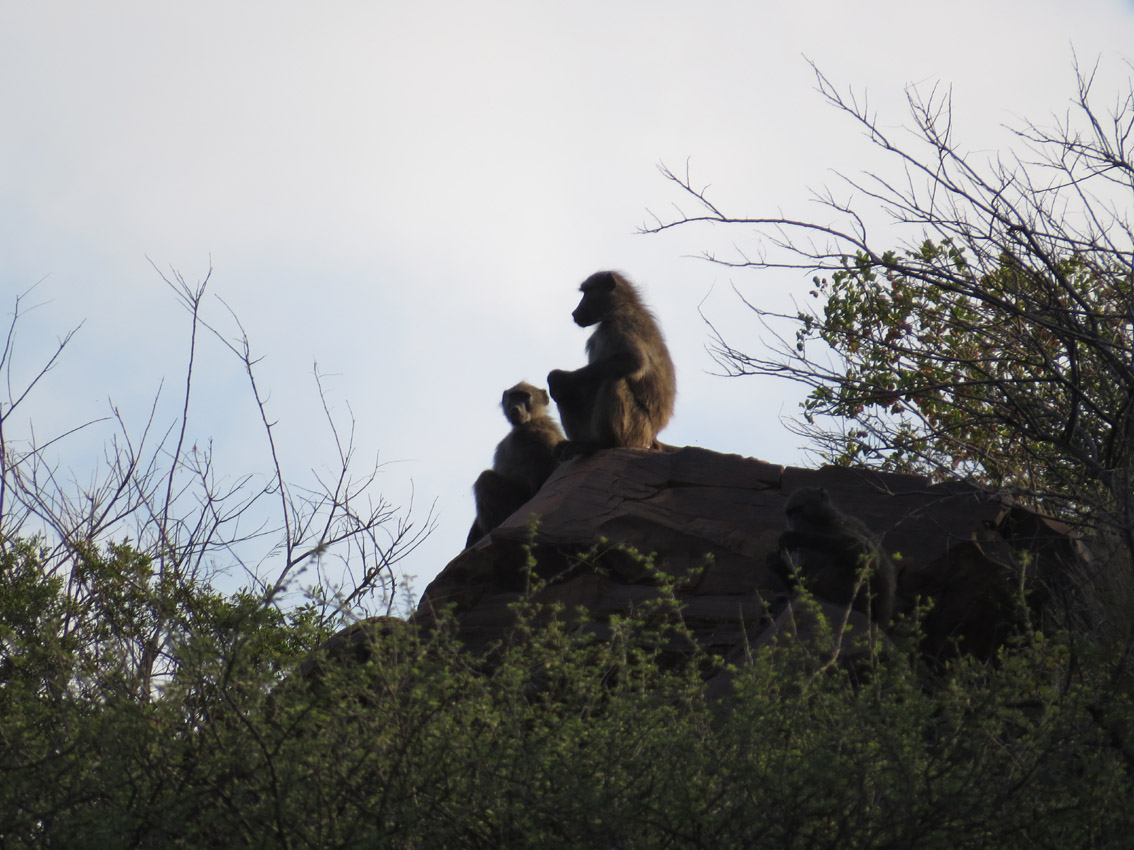
8. Baboons on the rock.
Baboon herds live at transition from rocks to the bush-covered plain, in the same places where impala display their rutting activities. So, our recording units were under permanent threat of baboons.
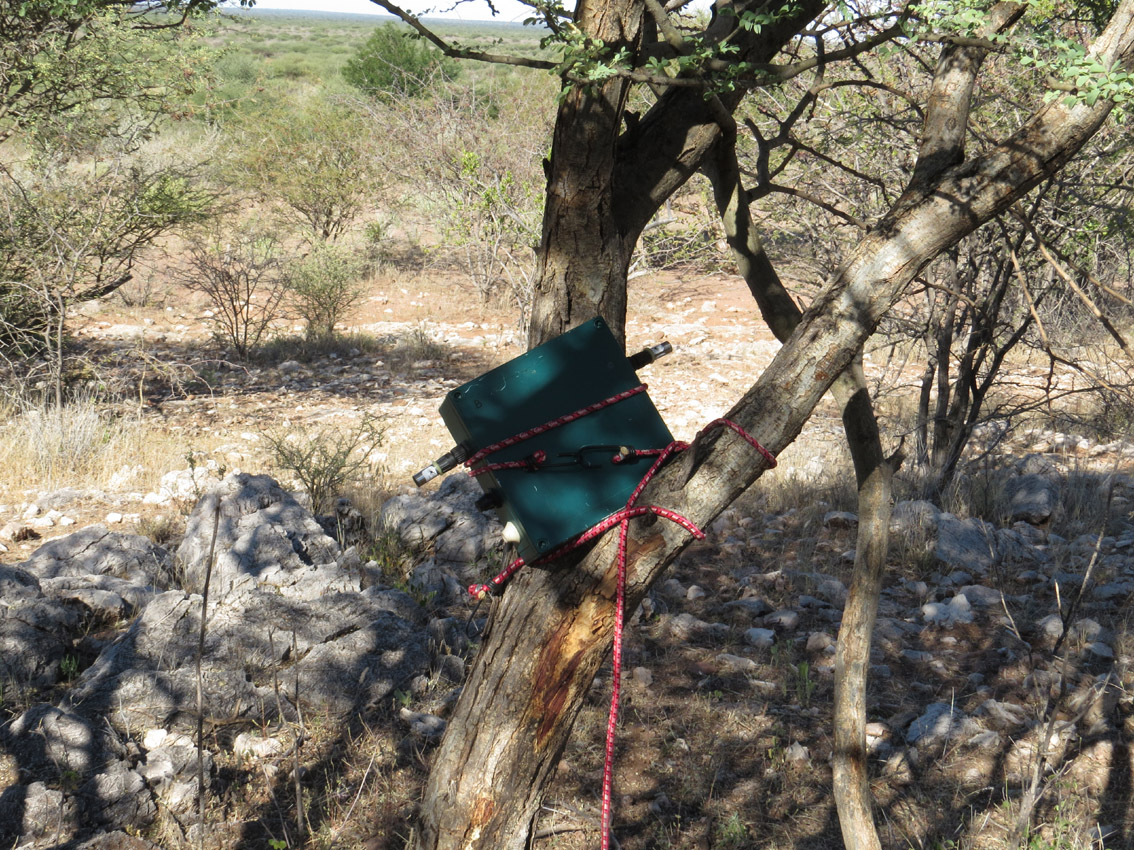
9. Songmeter damaged by baboons.
This songmeter was not placed inside the cage. As the result, baboons warped and broke the fasteners, picked of the windproof from the microphone and broken and turn off one of the two microphones. This particular songmeter earlier overwintered in severe Siberian taiga and survived during the terrible flooding and fire, - and still, was attacked by baboons in Africa! Fortunately, this unit is constructed strongly and works again after repairing of the damaged microphone.
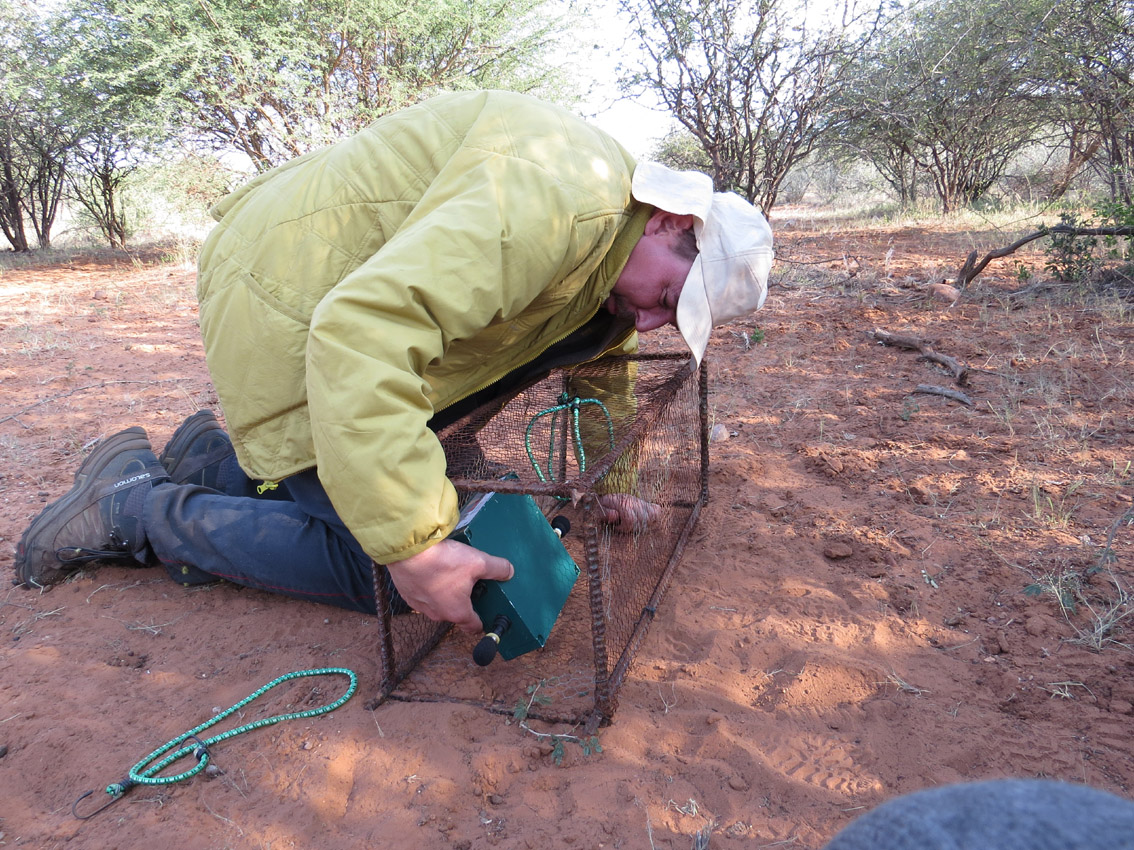
10. Protecting the songmeter in a cage.
All ways are good to avoid the damaging of the songmeter by baboons.
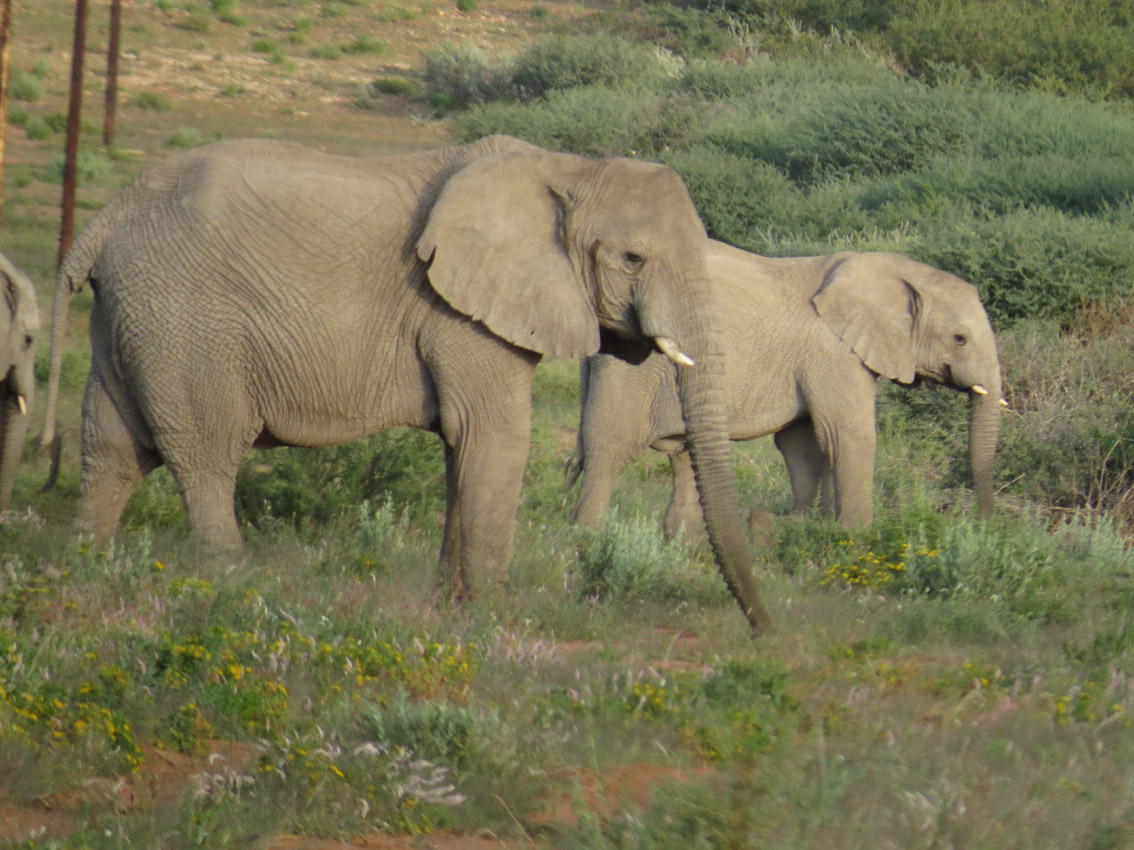
11. Elephants crossing the road.
On the Okambara farm, there is a herd of African elephants: a male, a few females and two young. Usually the elephants are peaceful, however better to stop the car and wait until they depart for a significant distance. Elephants spend nearly all time eating branches of bushes and trees, even at night. They are so large that need in a lot of food for supporting the energetic balance. By this reason, they never rise up by the slopes of the hills; this is too large energy expenditure for them.
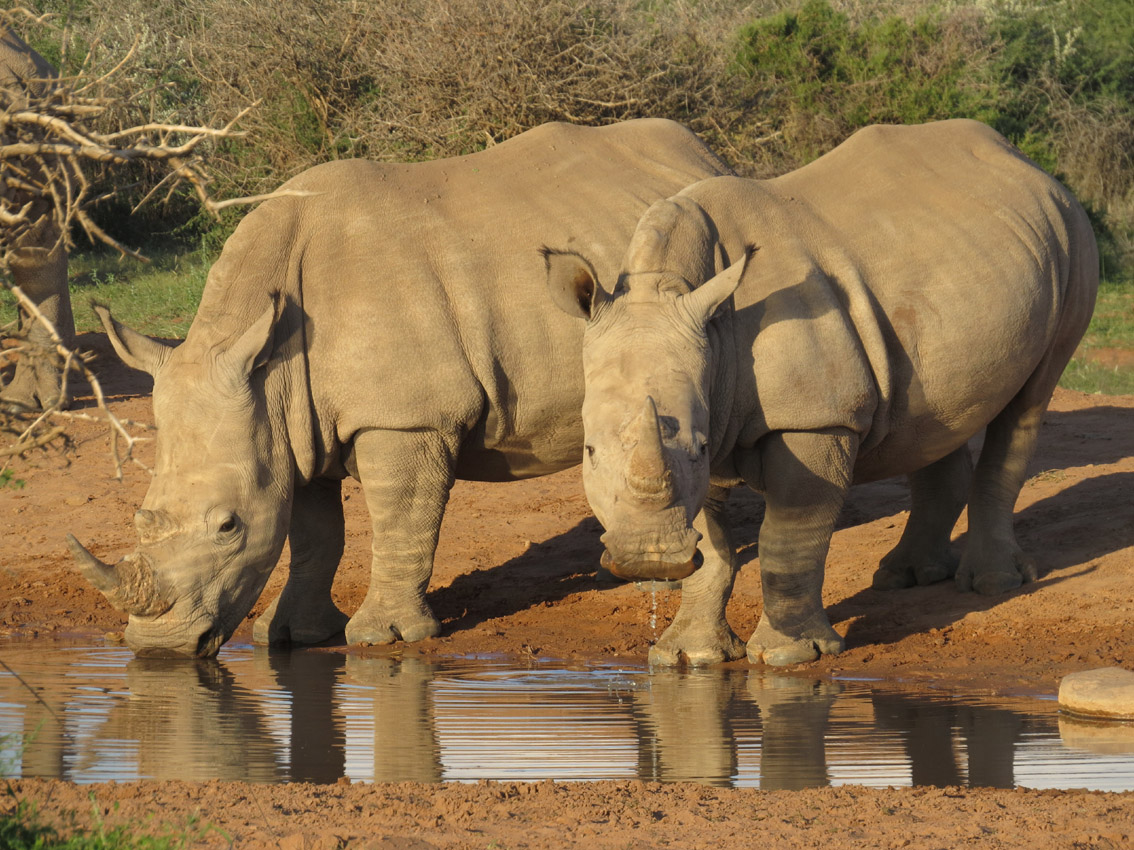
12. Rhinos.
On the Okambara farm, there is a herd of white rhinoceros, consisting of one male, three females and on young. The elephants and rhinos were specially bought by the farm owners for attracting the tourists. And they cause most damages on the farm. Elephants break trees, destroy water pumps and water cisterns, whereas the rhinos by unknown reason especially do not like the wooden electricity pillars.
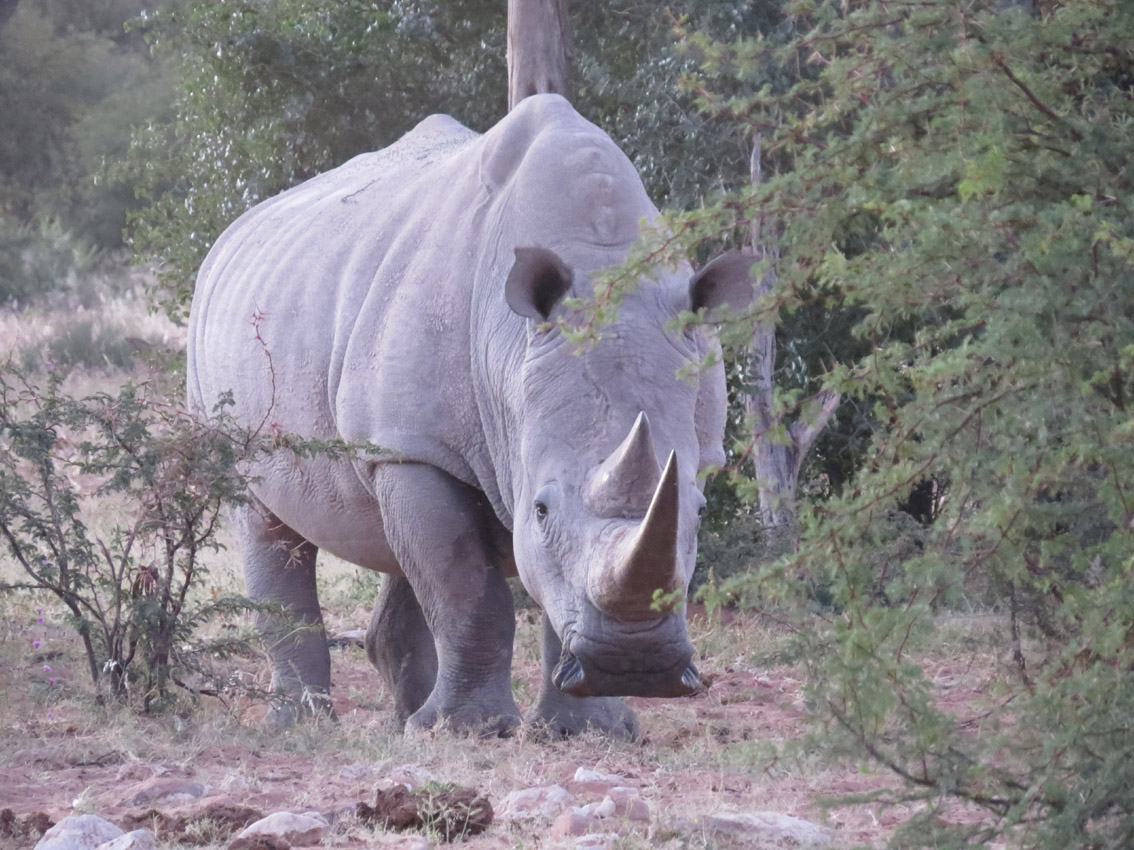
13. Rhinos.
Elephants and rhinos are most dangerous for humans on this farm. Escaping is impossible, climbing a tree too: the highest trees are 5 meters high and all covered with spines. Elephants move soundless and are invisible in bush even at 50 meters.
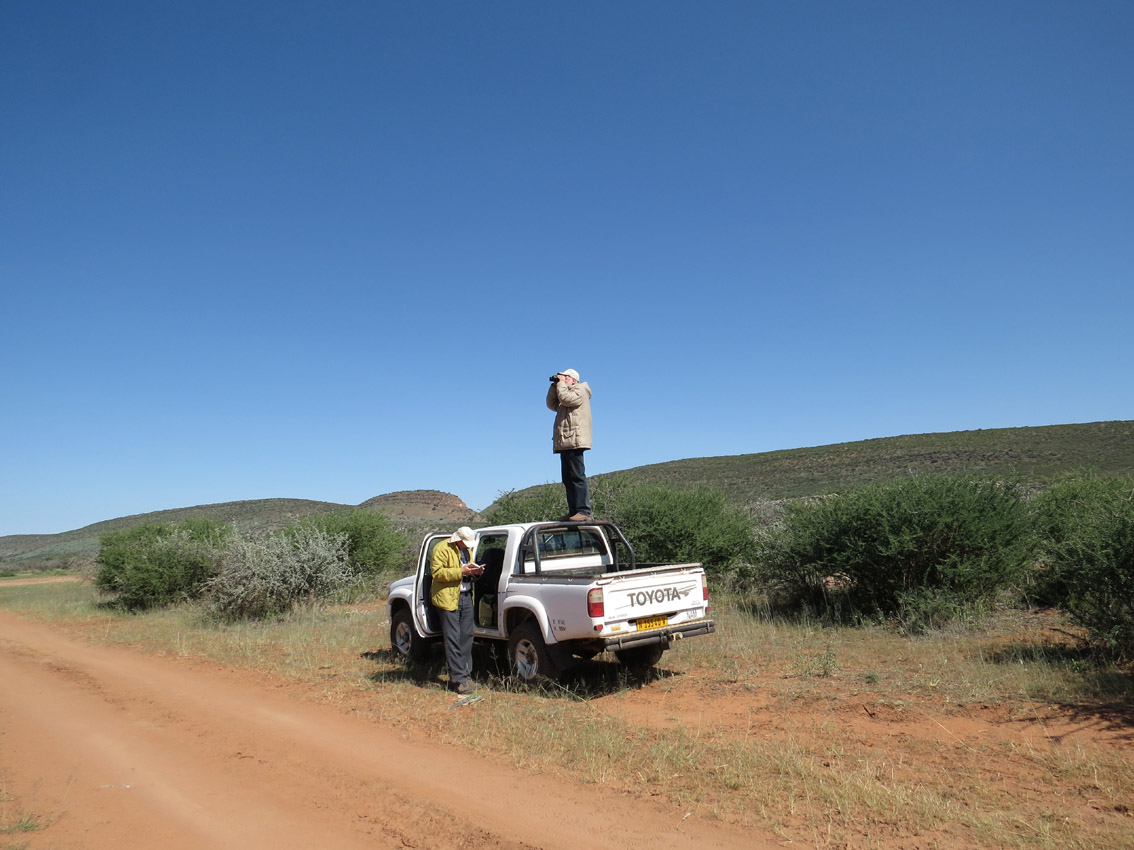
14. Elephant check.
A single defense is the car. To leave the car is prohibited for tourists. So, at any step out of the car we make the elephant check, by coming to the car roof and looking around.
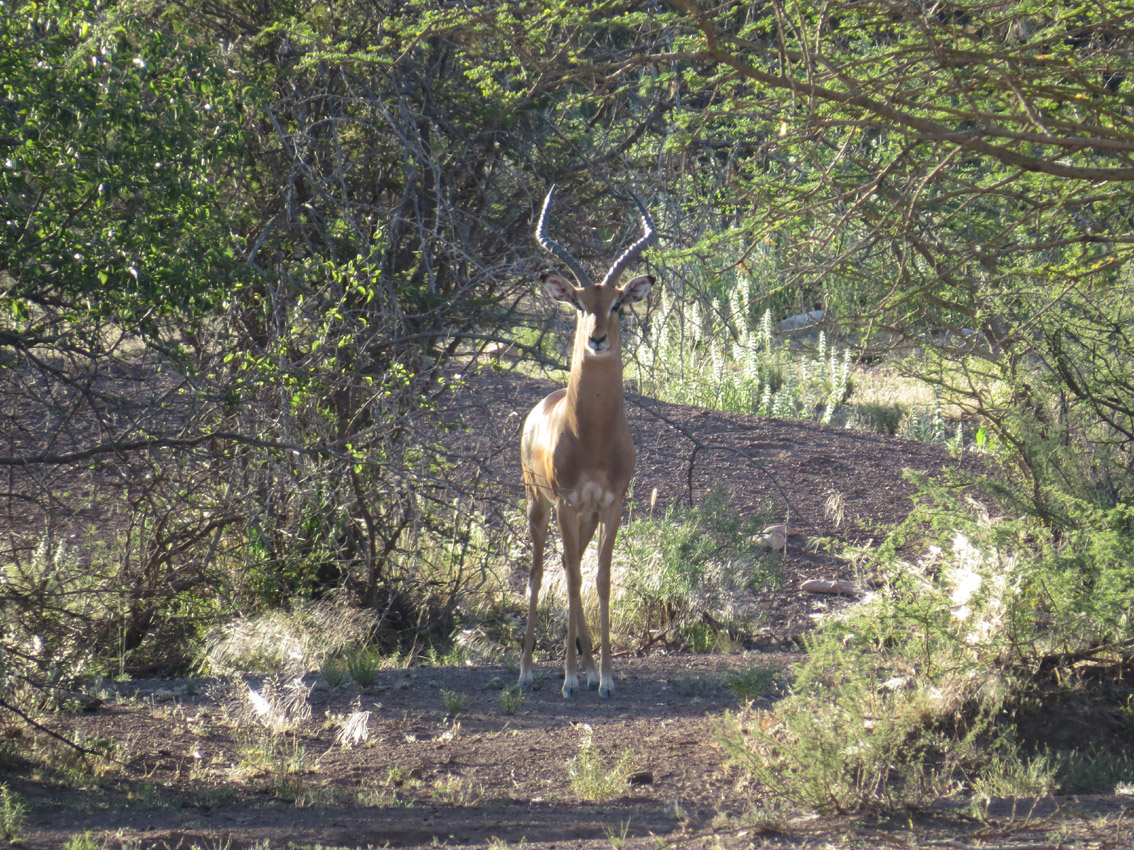
15. Impala male.
Impala mostly occur near the low mountain ridge along the farm over a dozen kilometers. As elephants, they do not go up to the rocks but also do not go to the plain. Now, at the beginning of May, is the onset of the rut period. Males occupy territories and start vocalizing, producing their rutting calls directed towards females and rival males. In May, the autumn starts in Namibia. Nights and mornings are still rather warm and temperature does not fall lower 10 degrees Celsius.
Male impala rutting calls: Aepyceros_melampus1_male_rut.wav
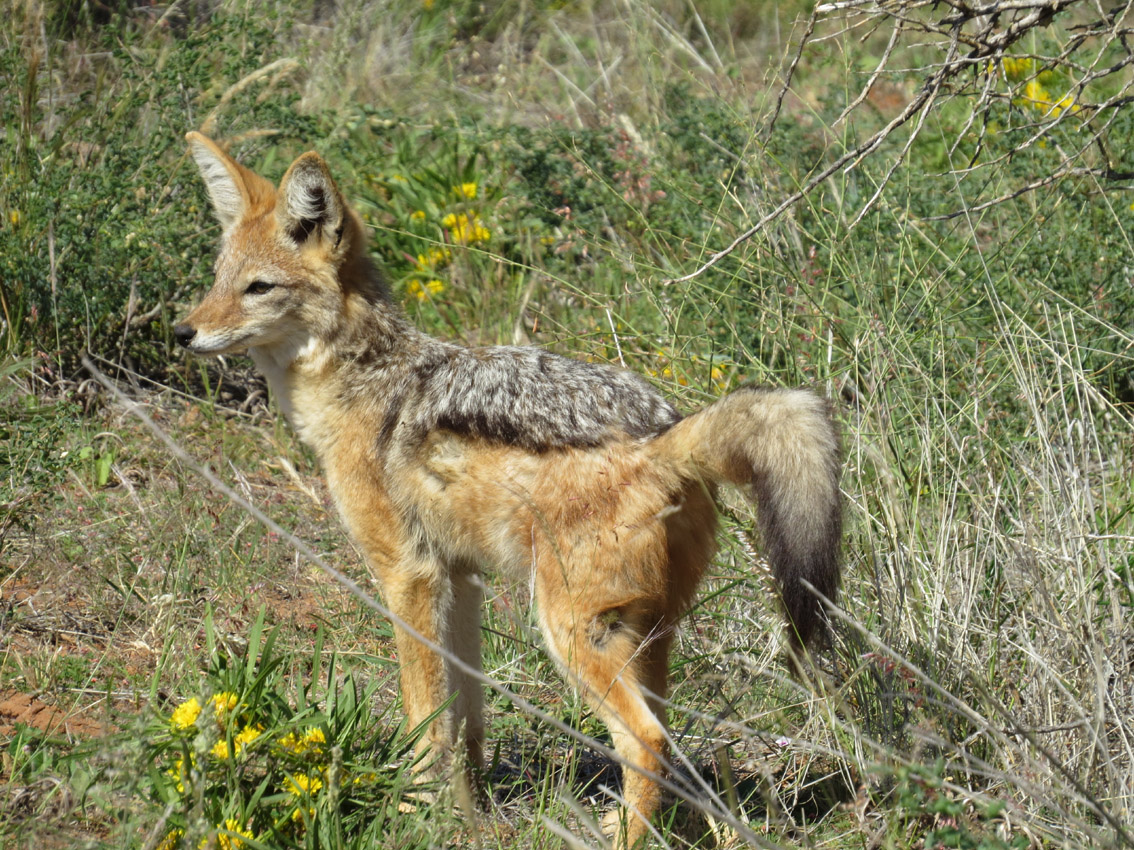
16. The black-backed jackal.
This is the most common predator on the farm. As a rule, the jackals are solitary and do not hunt in packs. However, before the evening hunting, they always howl together in chorus.
Black-backed jackal howling: Canis_mesomelas1_howl.wav
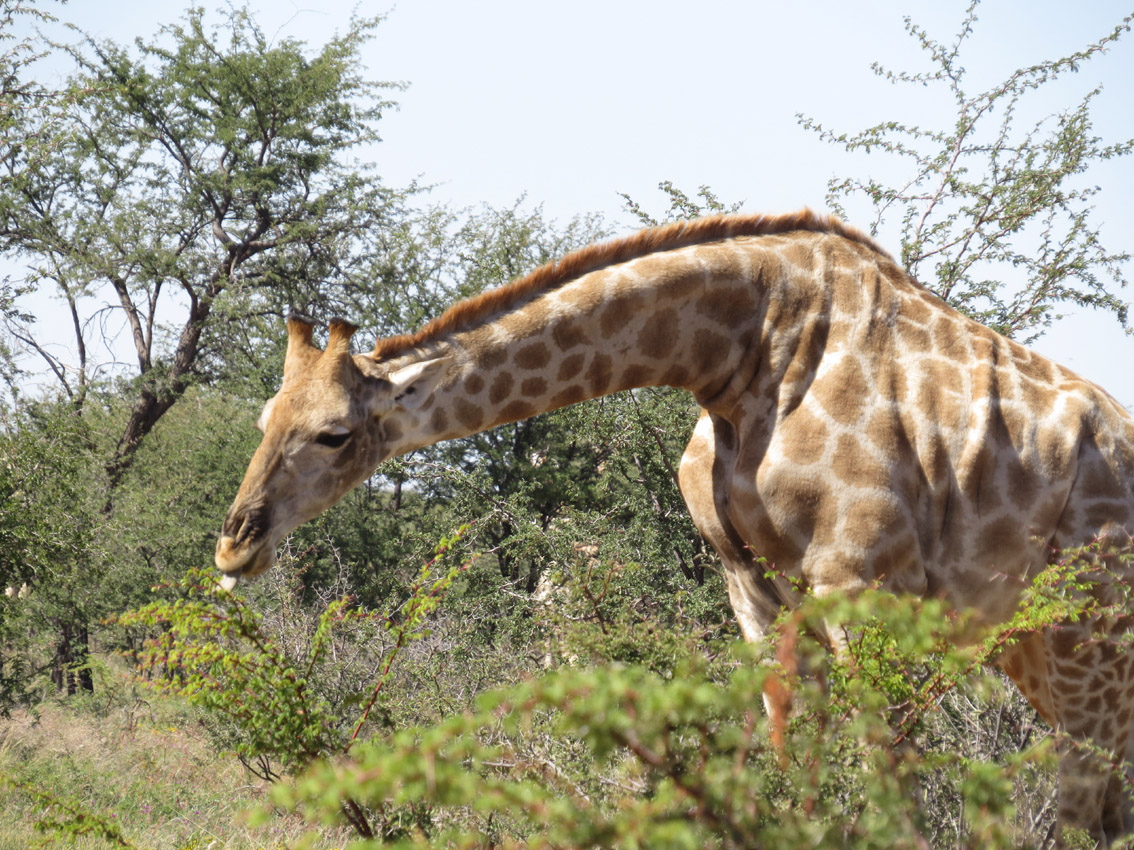
17. The giraffe.
The territory is mostly covered by dense spiny bush. Trees are rare and not tall. In this environment, giraffes do not especially need such a long neck.
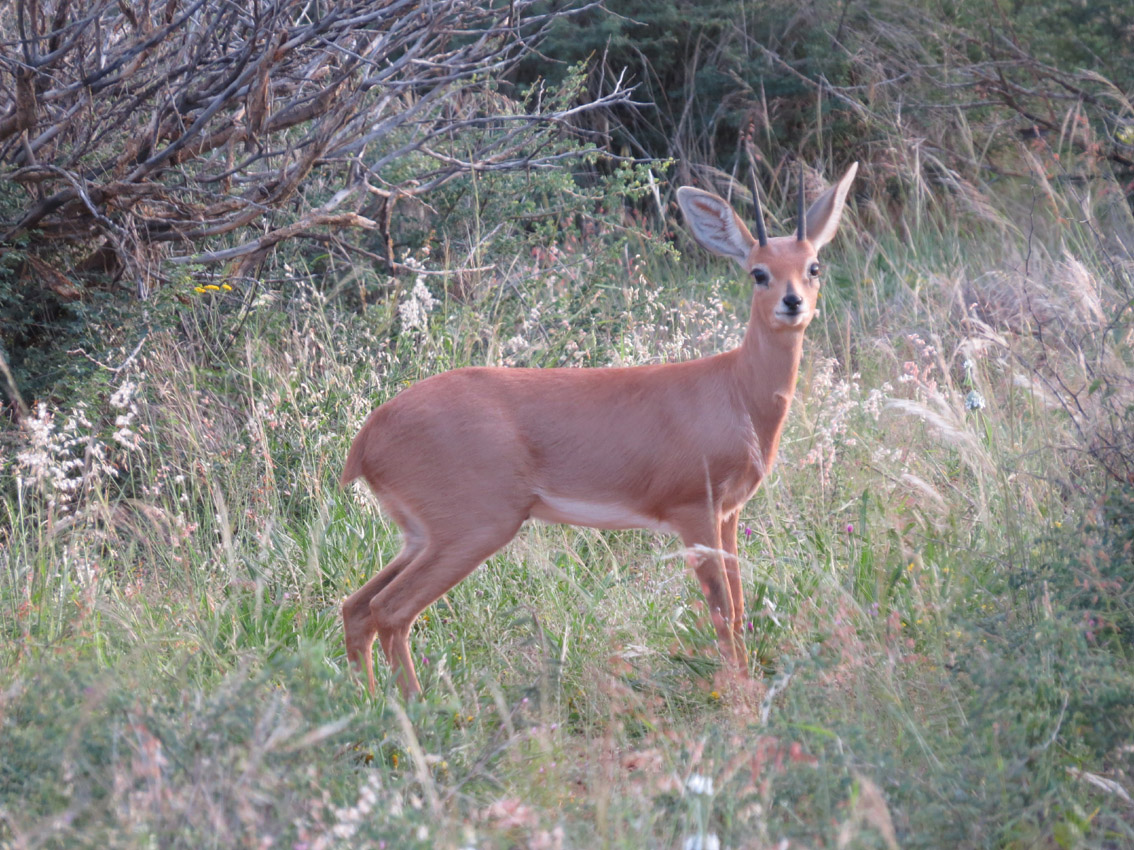
18. The steenbok antelope.
This is a small plain antelope. Only males have small horns.
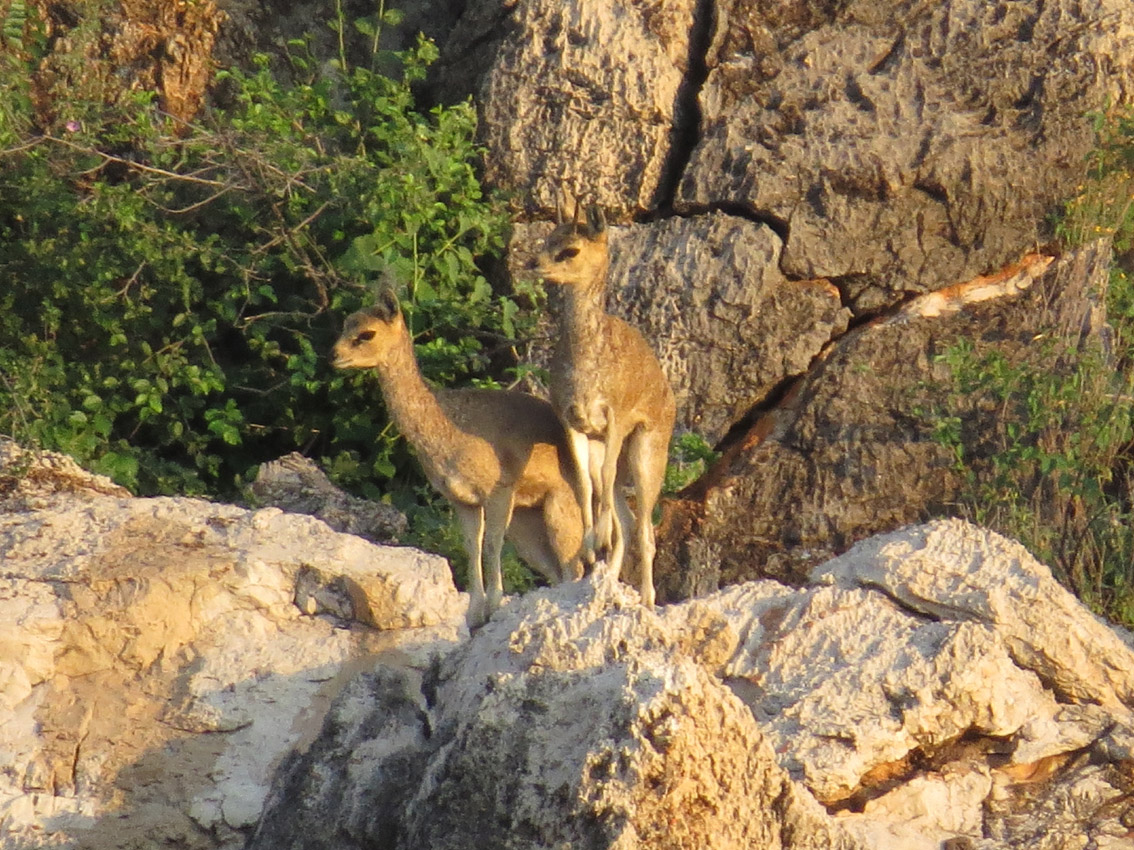
19. Rock antelopes - klipspringers.
Klipspringers stand on their hoof tips. These antelopes live in pairs on the rocks. An immobile klipspringer merges practically entirely with the background. We disclosed them only because the observational hide occurred to be placed just below their family territory. This resulted in prolonged mobbing series toward the observer by the antelopes. Should we say that in this morning, impala antelopes did not approach to this hide?
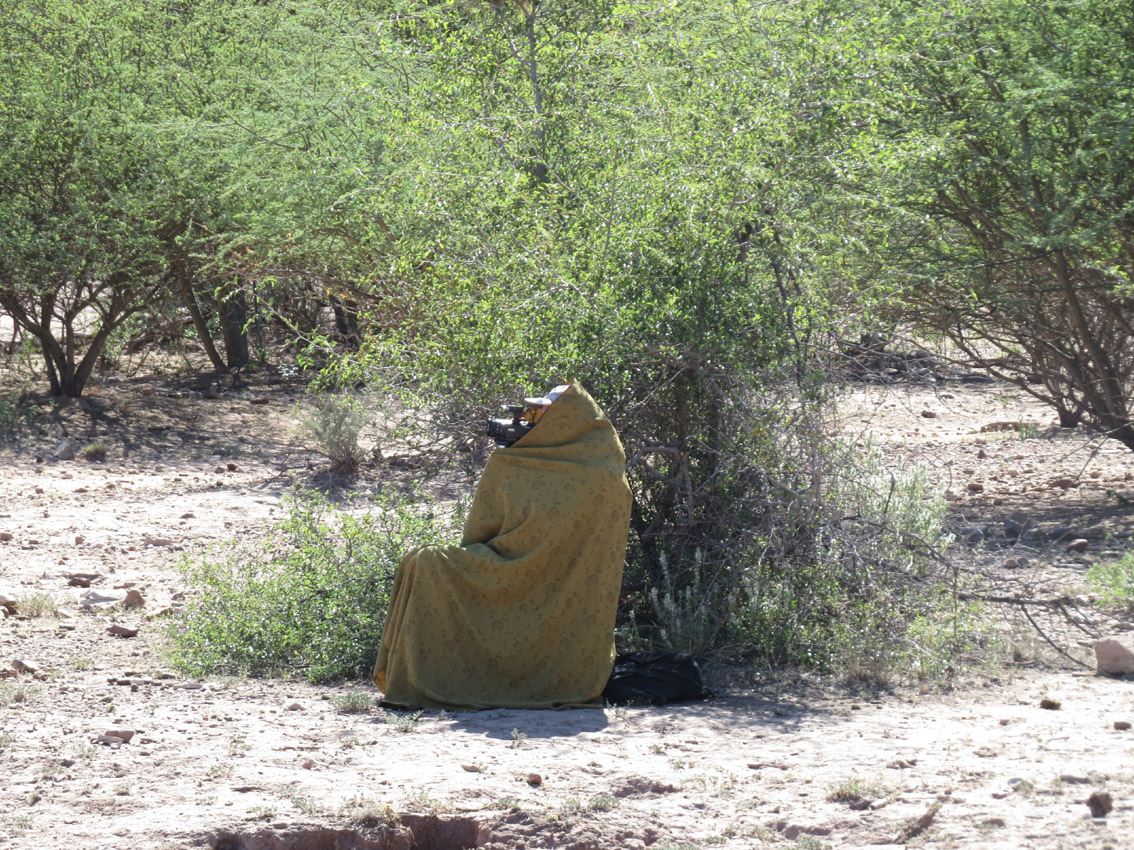
20. The observer in the hide.
To make good video clips of calling male impala, one should drive to the observational place at darkness and to sit immobile for hours. Impala are very shy and come out of bushes only in few places. For nearly two weeks, we could only rarely see impala red silhouettes among the bushes. It took much time to find these places and to make good videos of calling impala.
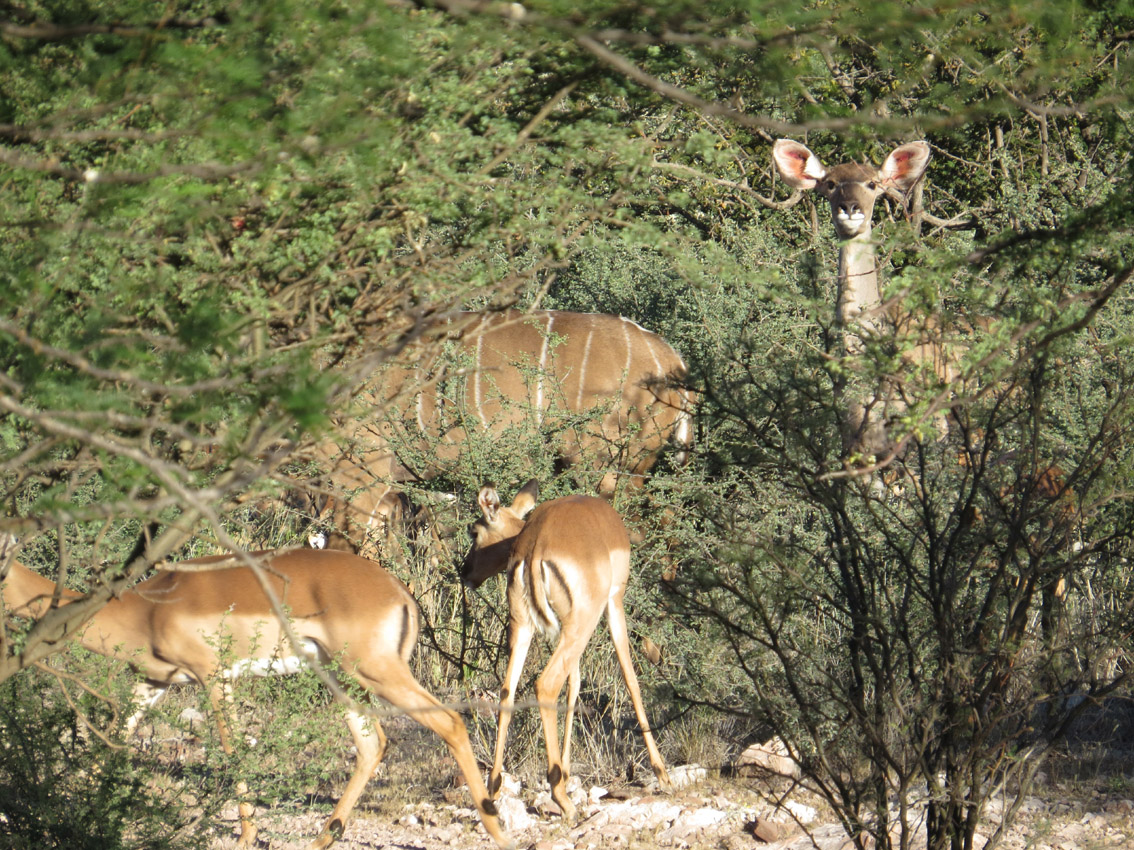
21. Female kudu head over the bushes.
Female kudu are most vigilant antelopes. Even impala may sometimes overlook the observer, whereas a female kudu will notice him for sure. They advertise every tier or bird around about the presence of danger with their loud alarm barks.
Female kudu alarm barking: Tragelaphus_strepsiceros1_alarm.wav
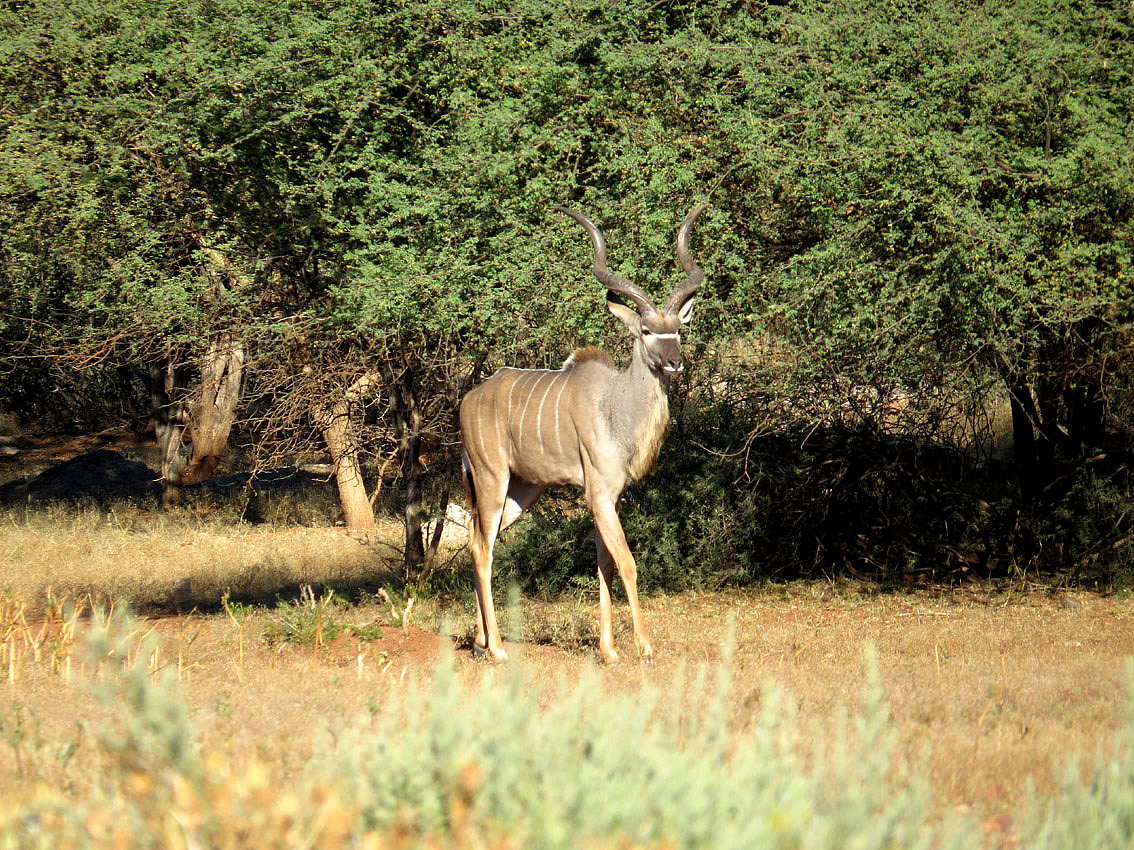
22. Male kudu.
Unlike females, male kudu never produced alarms toward the researchers. Kudu antelopes are native for these places, distinctive to some translocated antelope species.
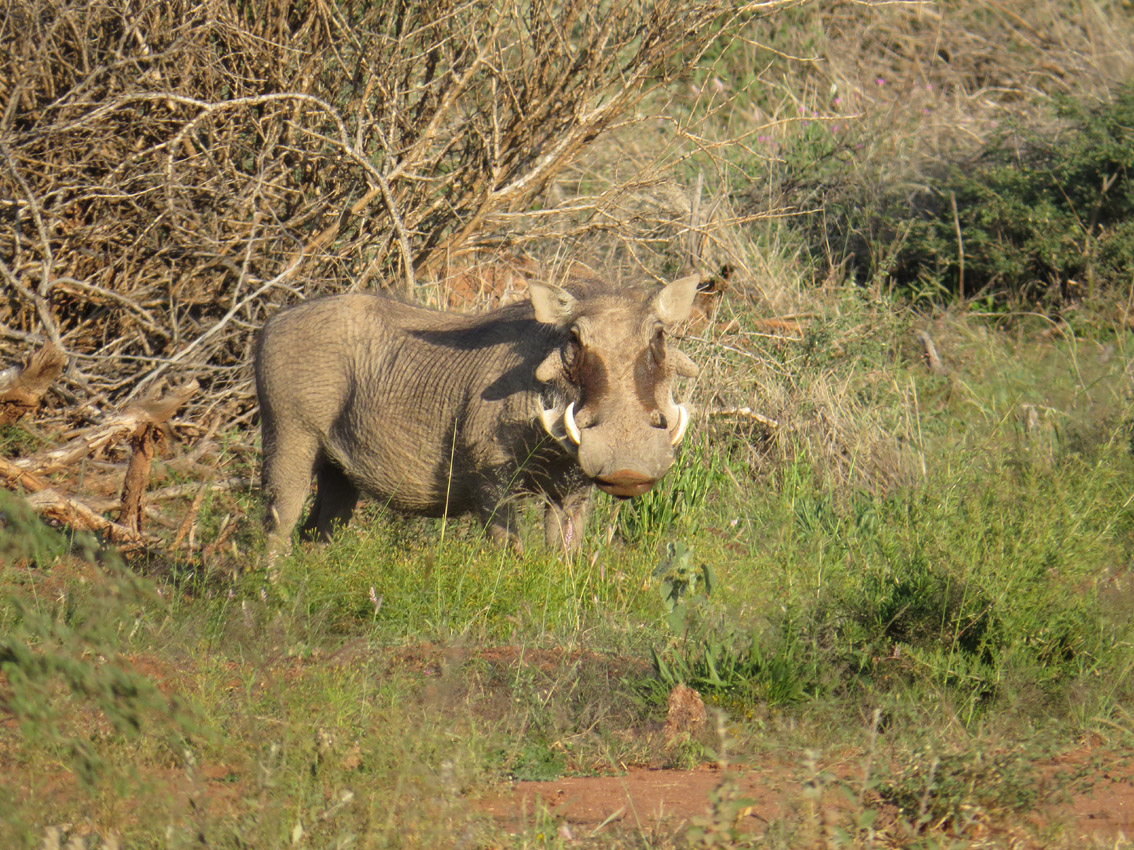
23. The warthog.
Another aborigine species is the warthog. Using their canines, the warthogs dig out deep burrows to hide there during the hot day.
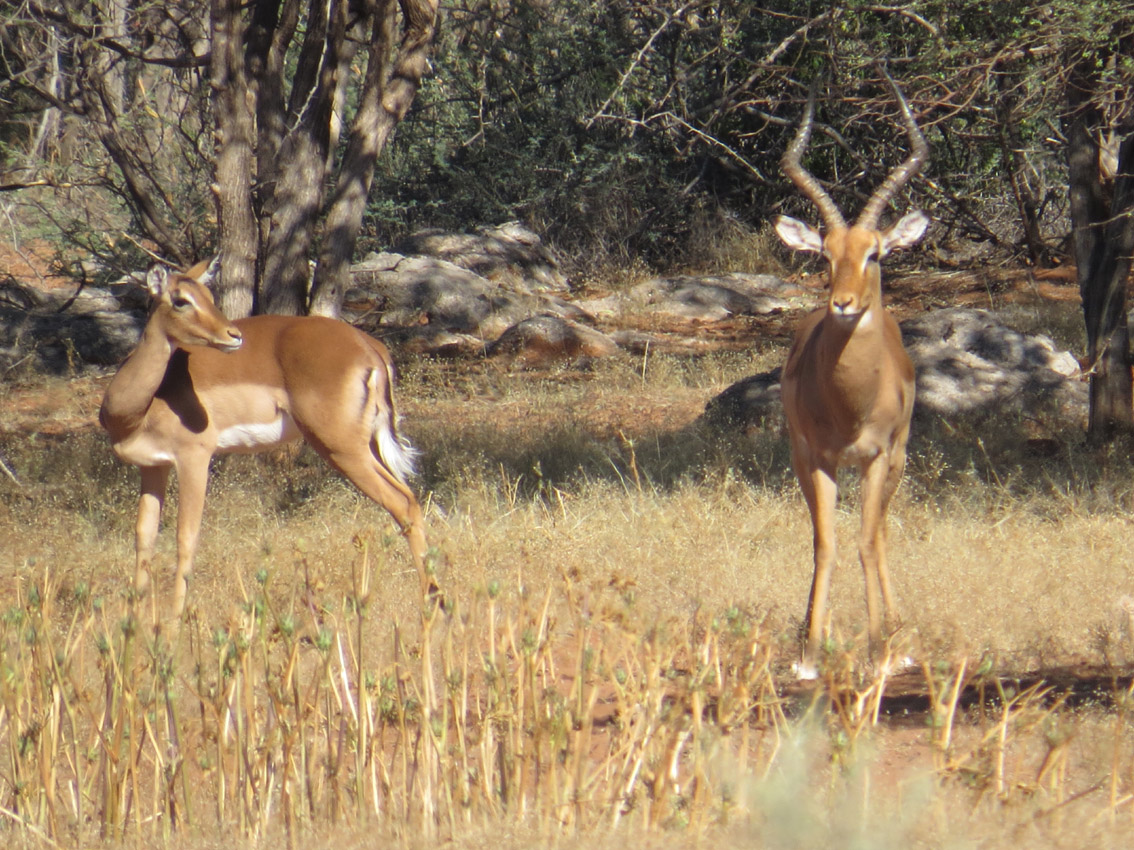
24. Male and female impala.
Impala are sexually dimorphic: males have horns, females do not.
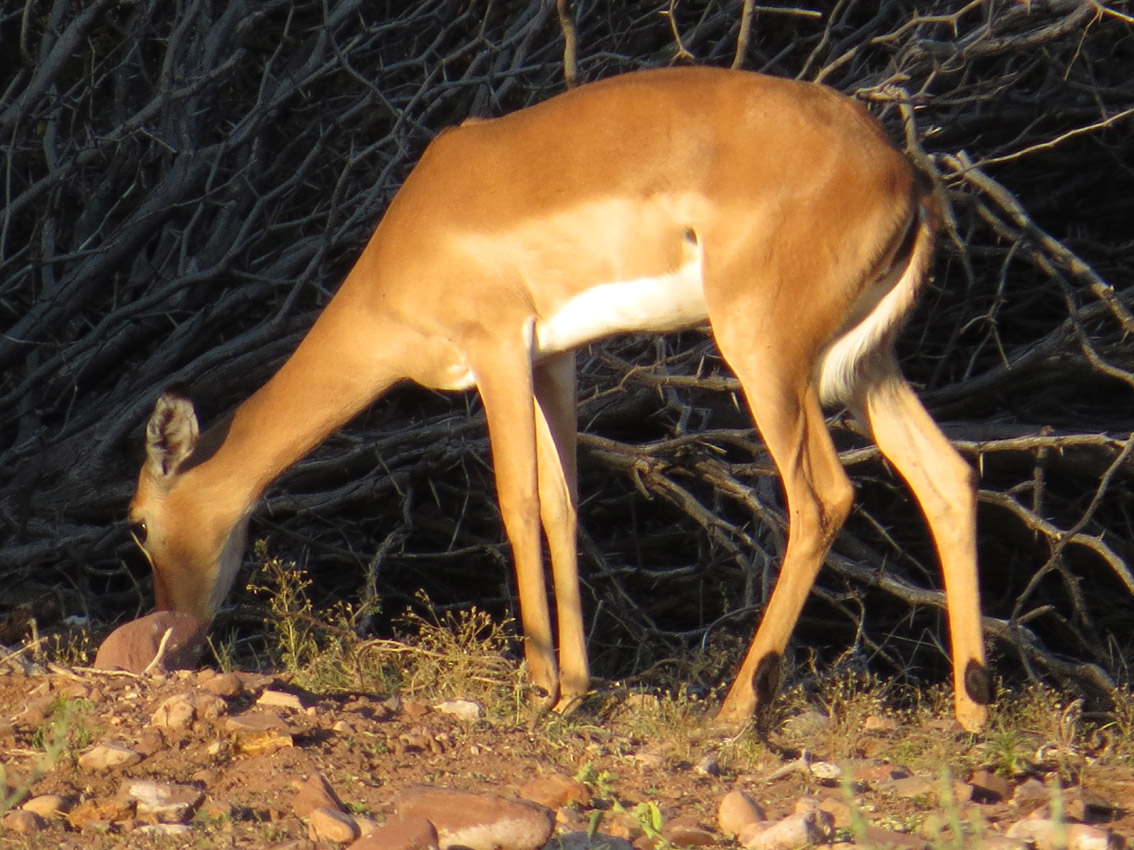
25. Female impala grazing.
Impala is the only ungulate with brushes of dark stiff hair on their legs. The function of this hair is unknown.
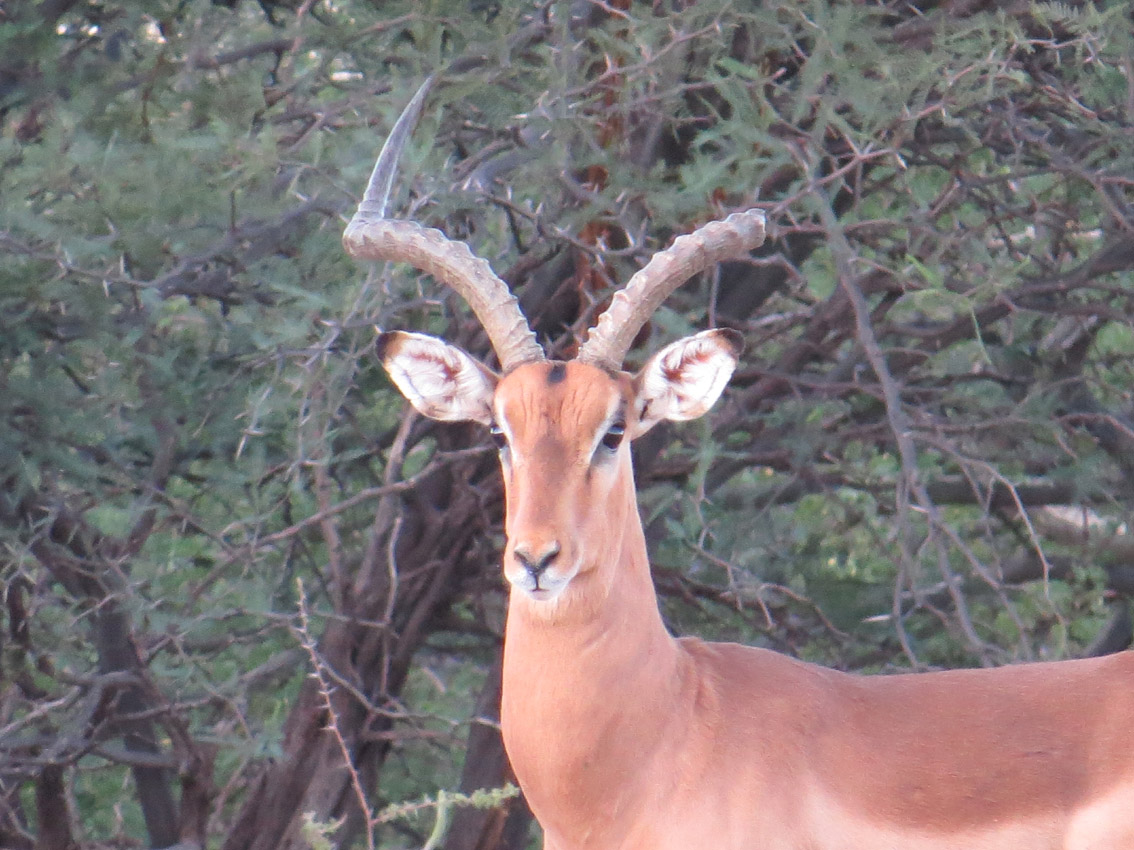
26. Impala male with broken horn.
During the rut, fighting impala males often break their horns and injure each other. Such injured males with broken horns are still strong enough to hold their harems and defend them from other males.
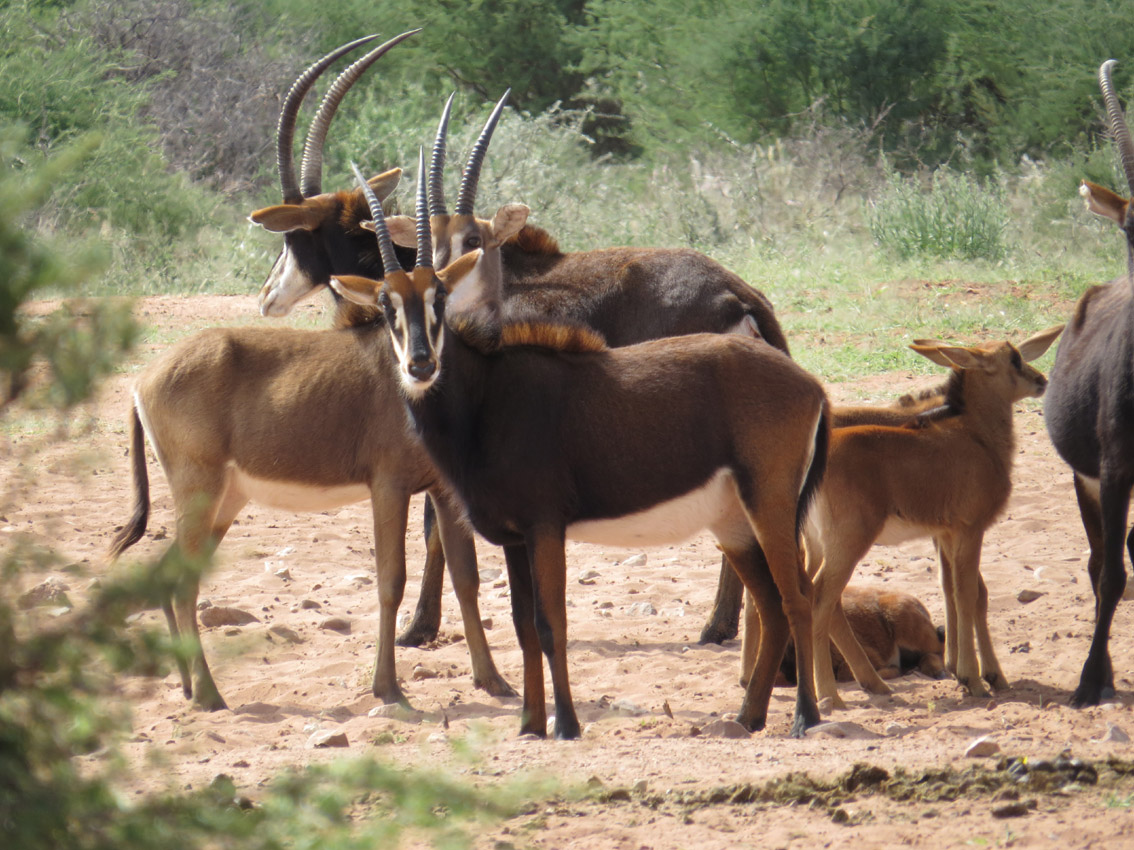
27. Sable antelopes.
These animals with sable horns live and breed well in many zoos, including Moscow Zoo, in spite of the strongly different climate compared to their natural habitats. These antelopes are very silent.
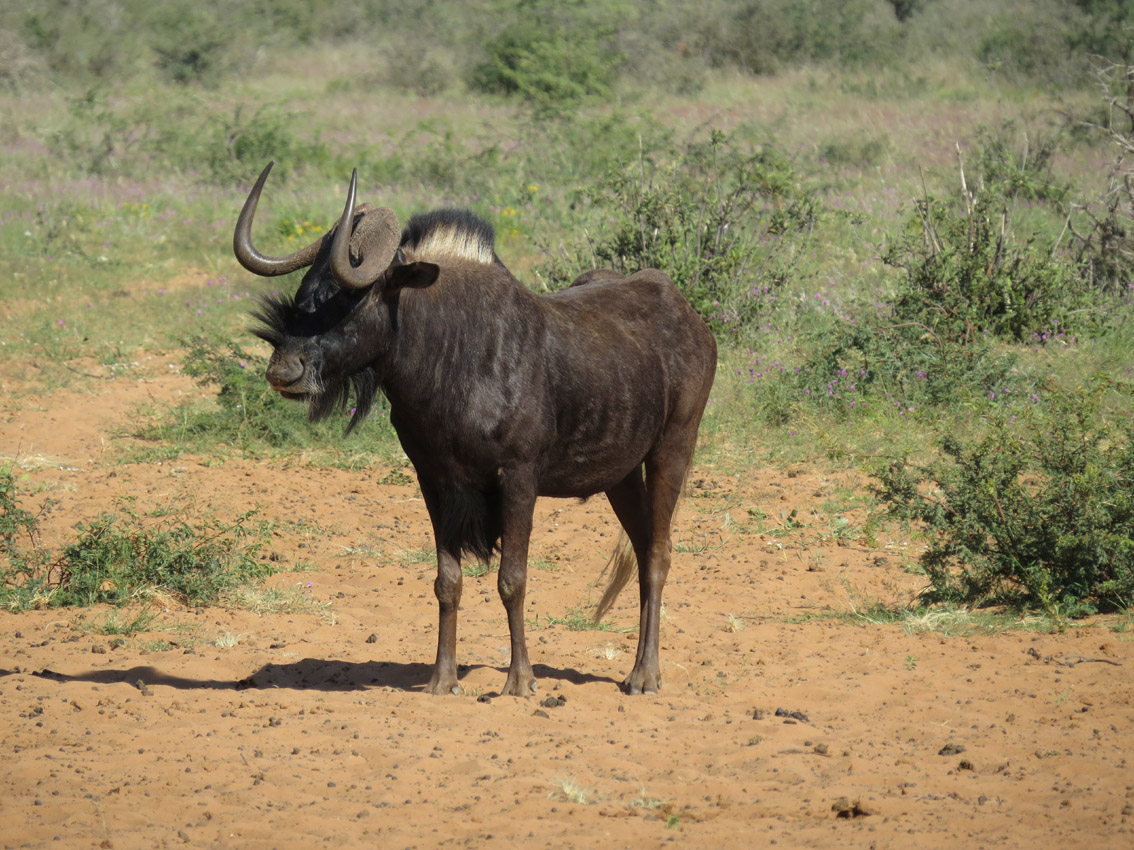
28. The white-tailed gnu.
Unlike sable antelopes, this old male white-tailed gnu did vocalize every evening. It did not afraid of people and posed for tourists for good close-up photos.
Calls of an old male gnu: Connochaetes_gnou1_male.wav
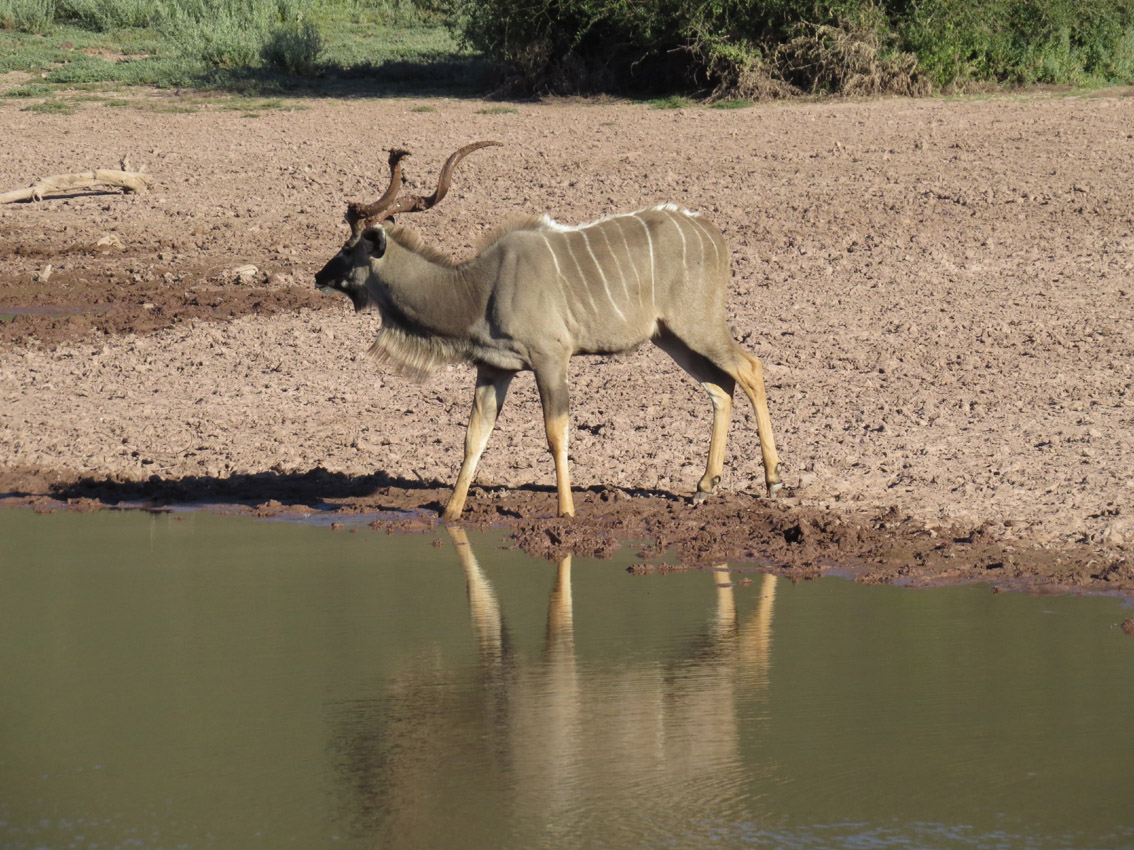
29. Male kudu near the water post.
Now is the dry season, so the natural water pools are lacking. All water has been stored during the wet season (November-March). Now it dried out. So, people should take care for water for the animals. The water posts, as a rule, represent just large deeps in earth, either natural or dug out, to which water should be supplied by the pump. Previously, the Okambara was the cattle farm and the water posts retained since those times.
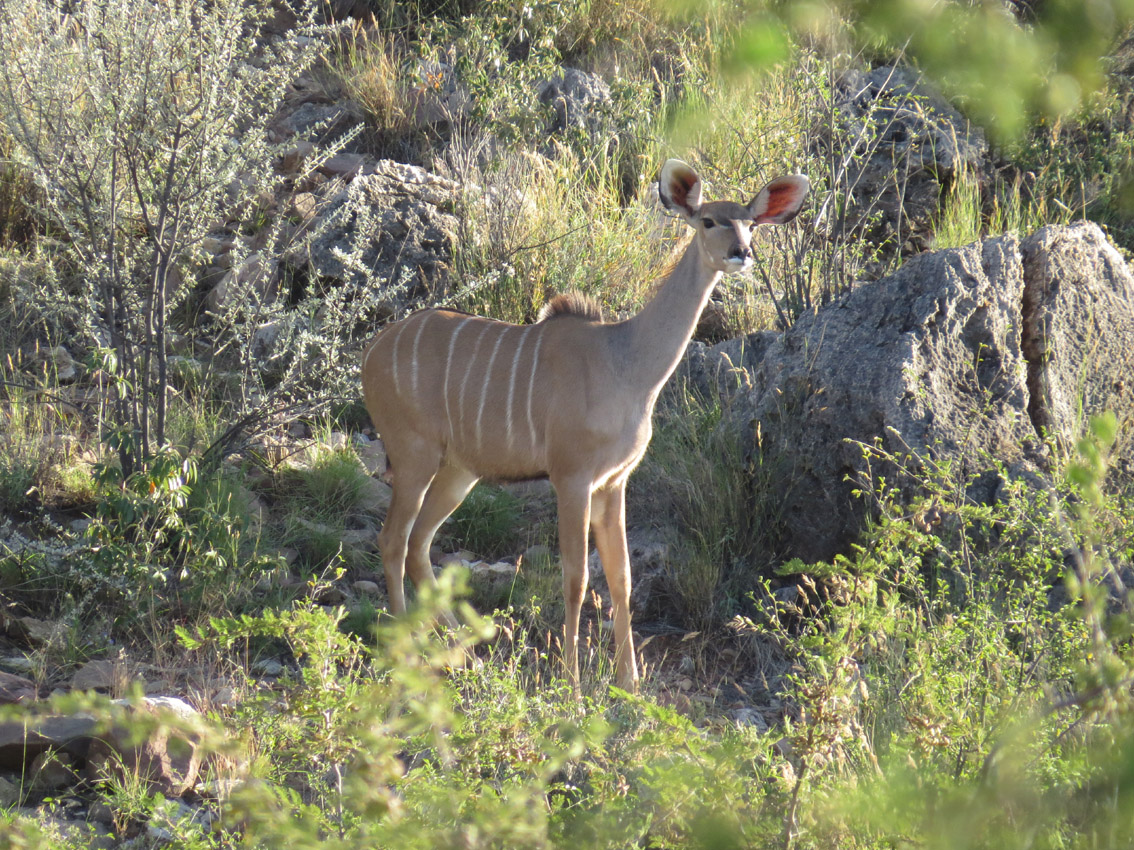
30. Female kudu.
Female kudu are very curious and very shy simultaneously.
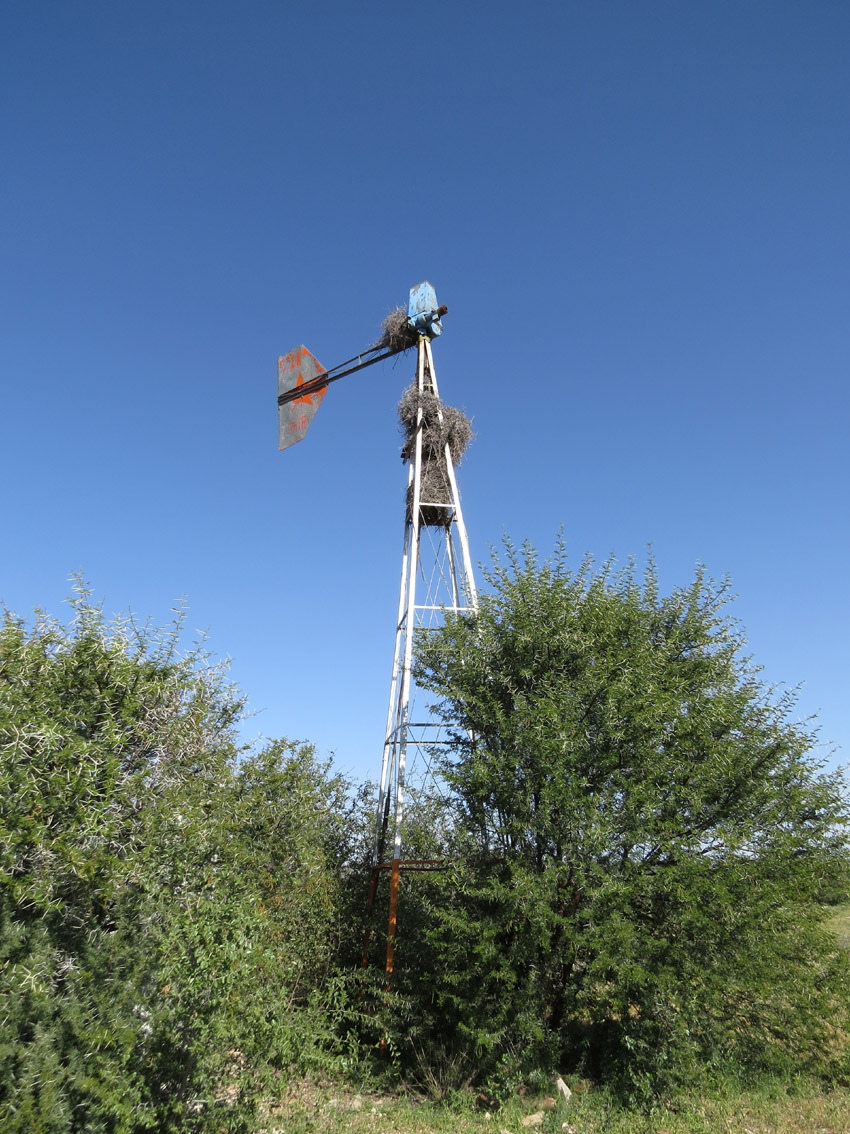
31. The old wind turbine.
Formerly, the water pumps worked from the wind turbines, because the winds are very strong here.
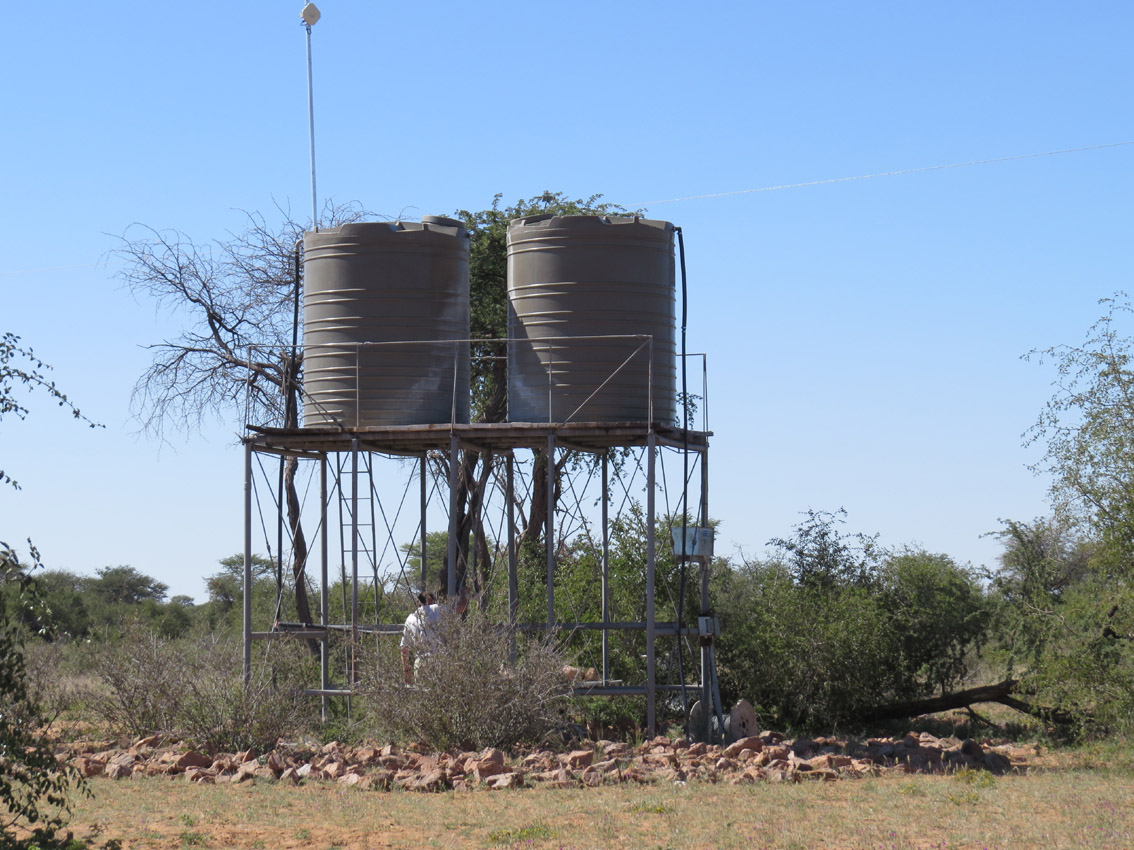
32. The water cisterns.
Contemporary water pumps work from solar panels. The Namibian plateau is elevated over the see for one and half kilometers even on the plain, and the mountains are additionally elevated by 300-500 meters. Thus, the solar radiation is very strong. The problem arises if, when one fills the pool for the animals and forget to switch the water from the pool to the living house until 3 h p.m. The cisterns will be empty up to the next late morning, when the sun will start heating enough strong to trigger the solar panel driving the water pump.
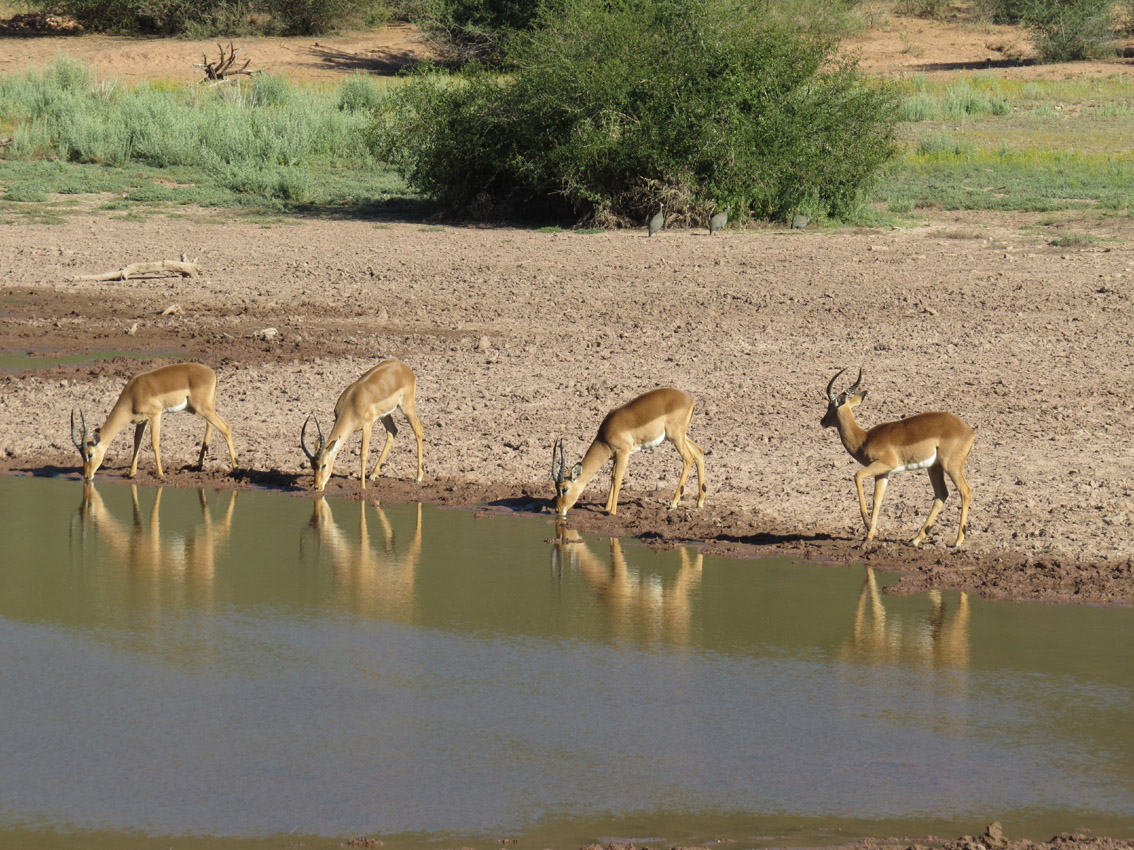
33. Water armistice - impala males drink water.
The water posts are always located on open places, appropriated for making videos of impala behaviour. The strongest males occupy their rutting territories near the water posts and await females that come to drink. But even in the middle of the rut, males do not interfere their male rivals to drink.
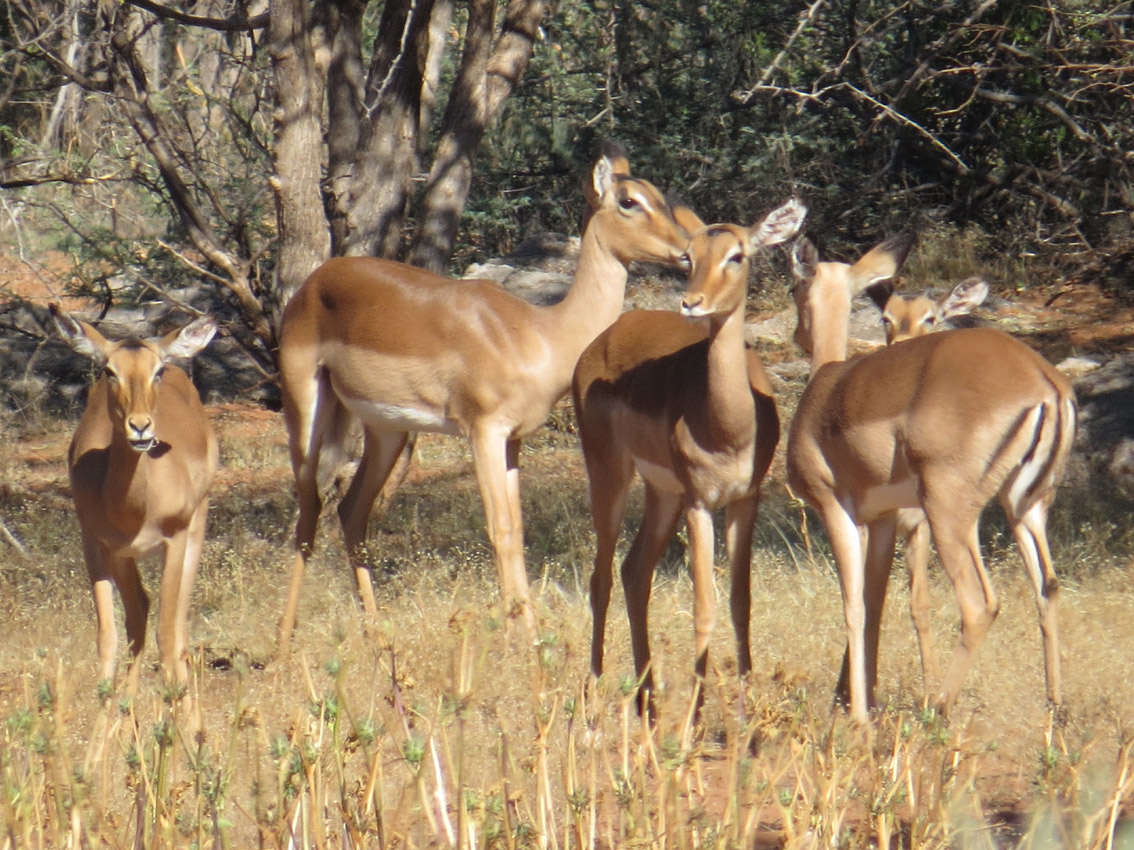
34. Female group coming to the water.
During the rut, females often go in groups from two-three to about twenty individuals.
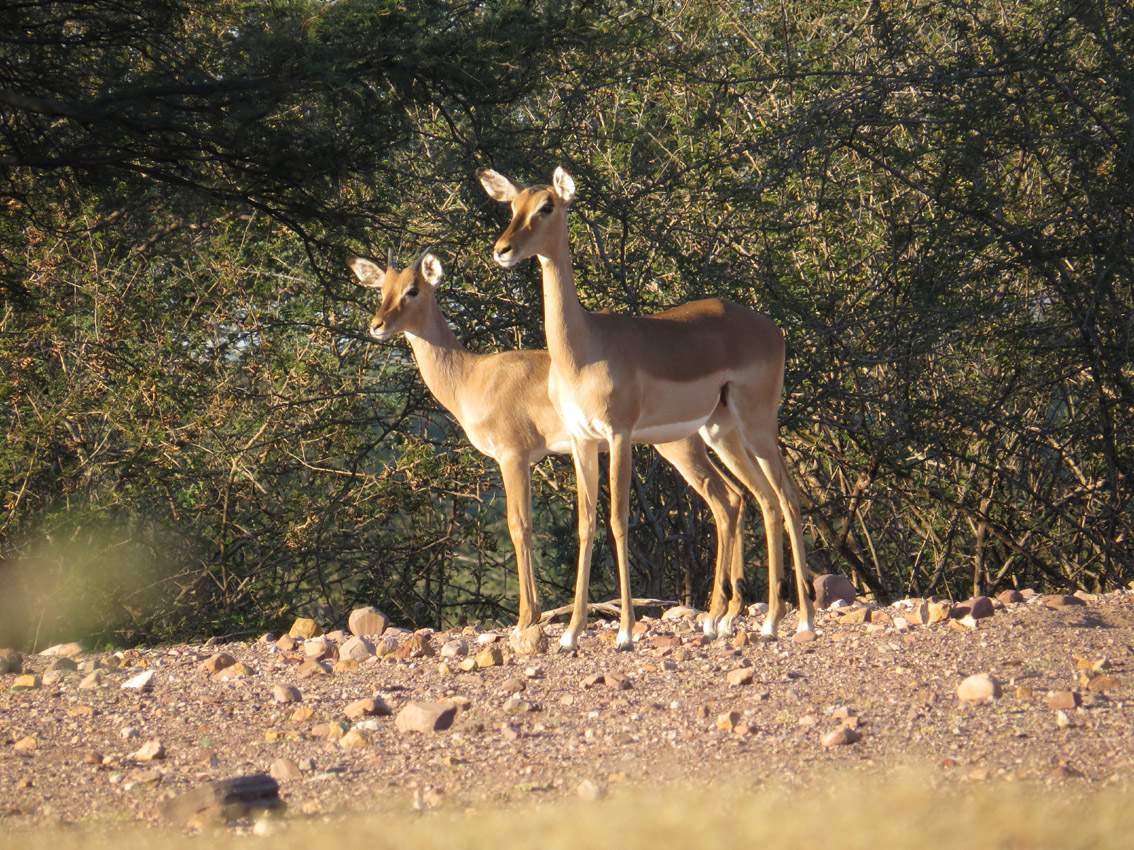
35. The female impala with the yearling.
The yearling can follow its mother.
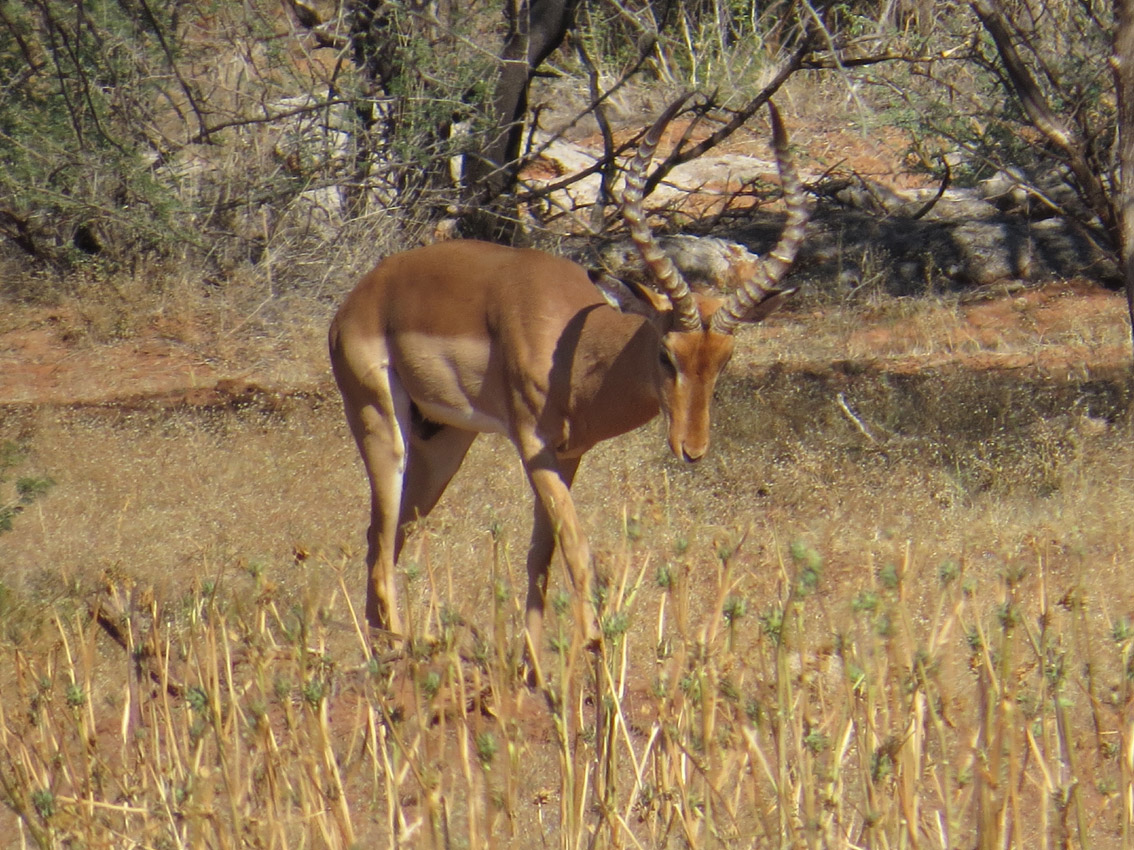
36. The rutting male in threatening posture.
Threatening male lowers the head and displays the splendid lyrate horns to real or apparent rivals.
Video:The territory holder is running towards the intruder, then males start thheating each other: raise their tails, open their mousse and lick their lips. Aepyceros_melampus1_male_rut.avi
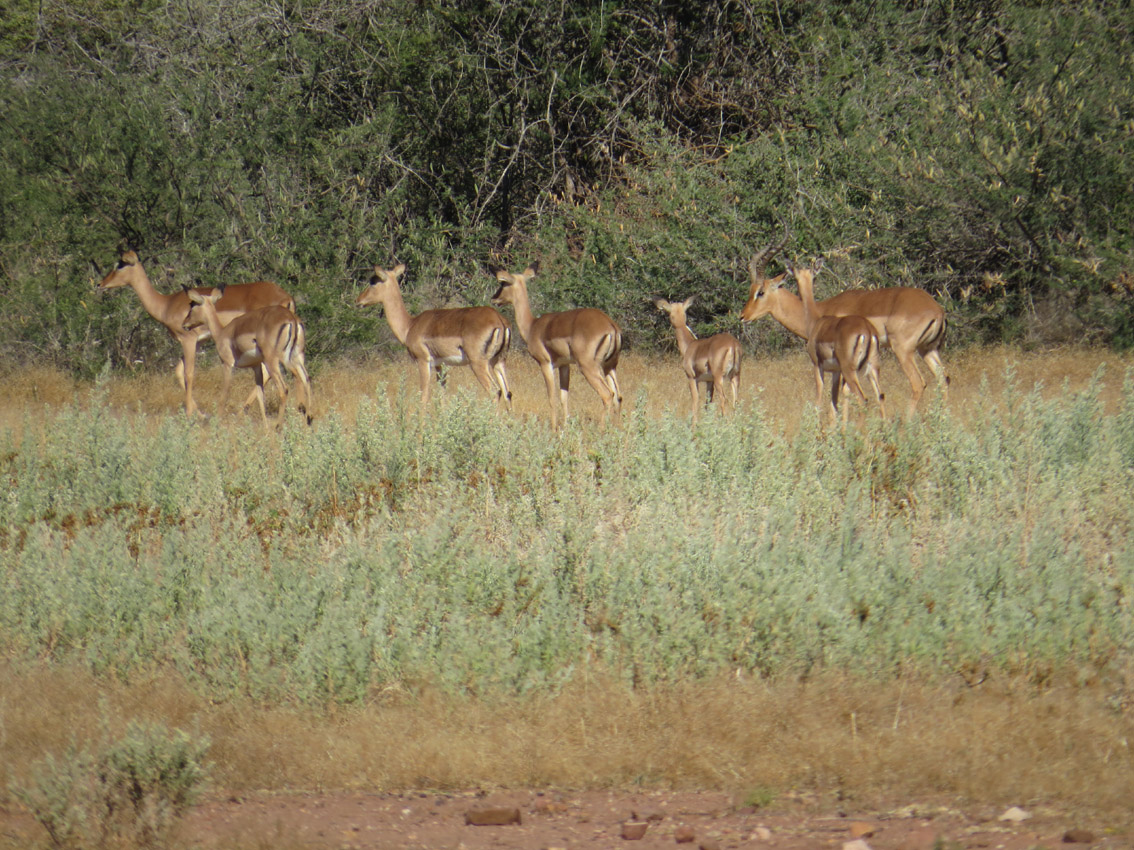
37. Harem holder impala.
Some impala males gather a harem of a few females and guard it against other males, instead of guarding the territories.
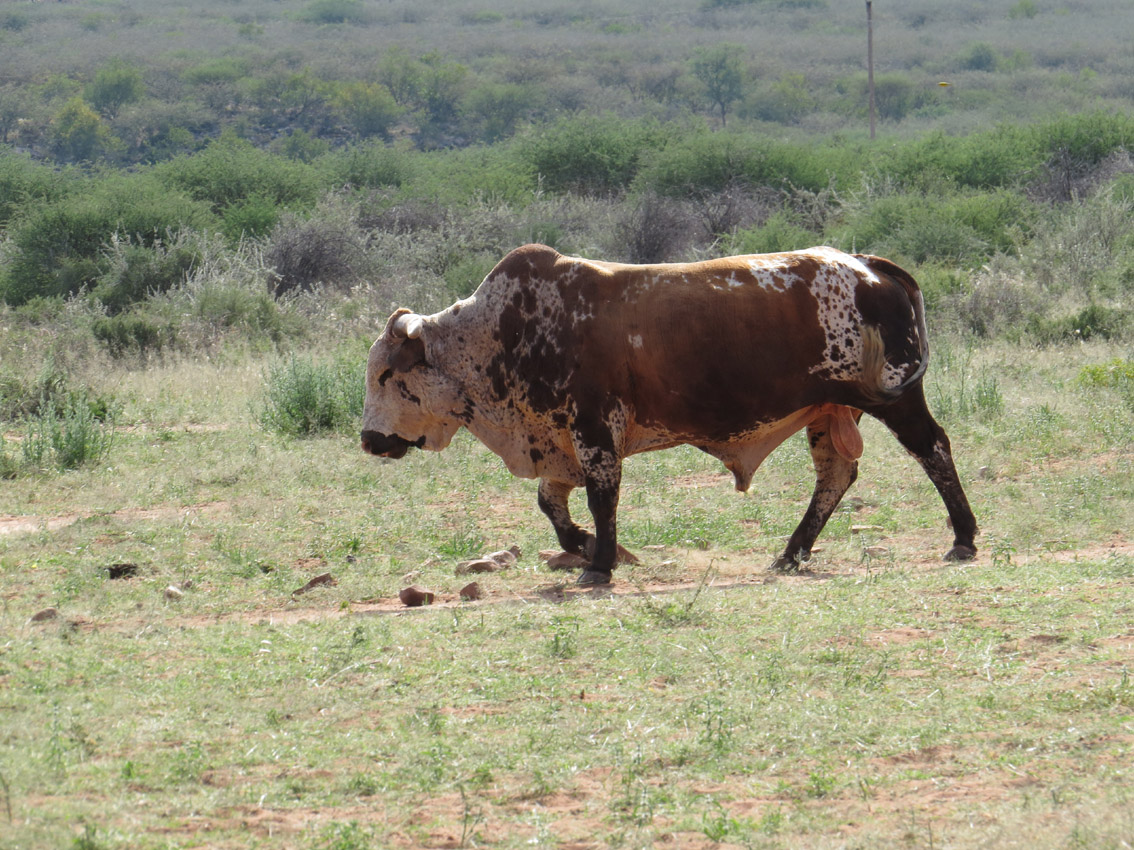
38. The bull.
For obtaining the cattle capable of living in the Namibian bush, various breeds were brought from everywhere. This bull probably, originates from the Brahma cattle.
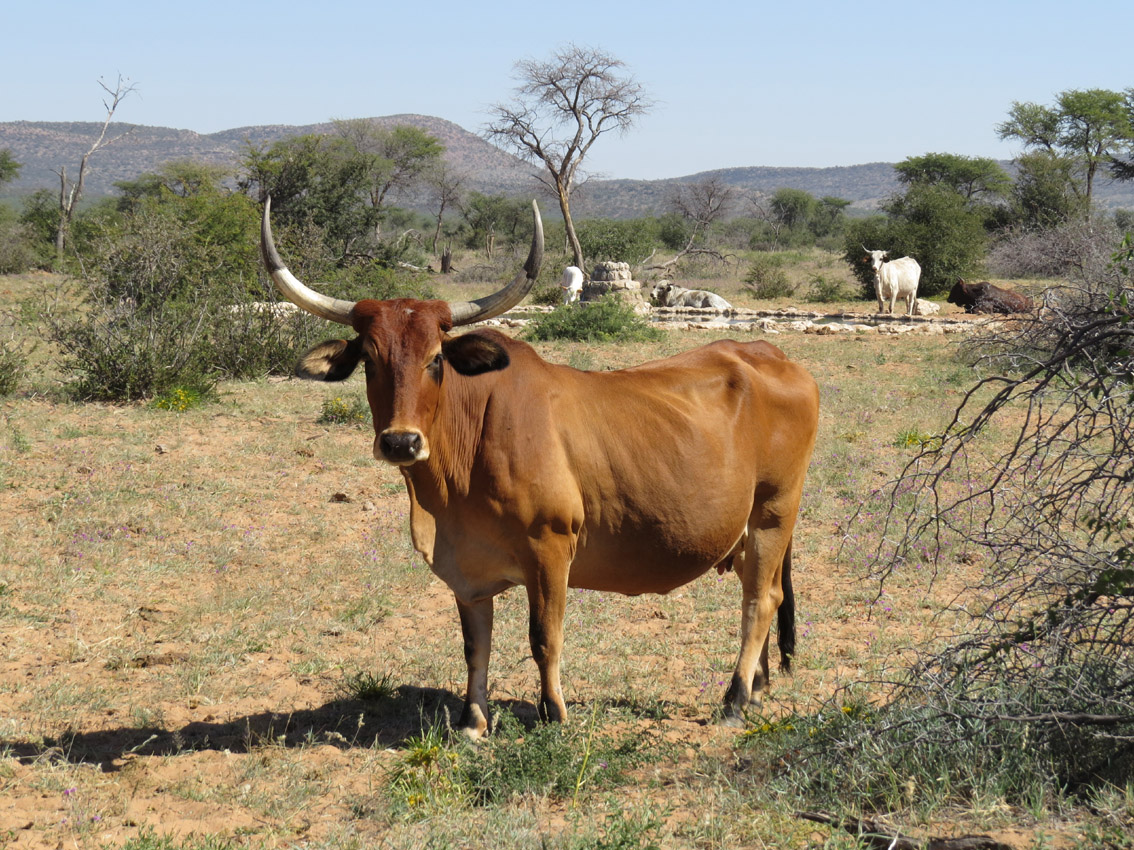
39. The cow.
Ancestors of this big-horned cow probably originate from India. There are also Alpine cows and the crossbred cattle.
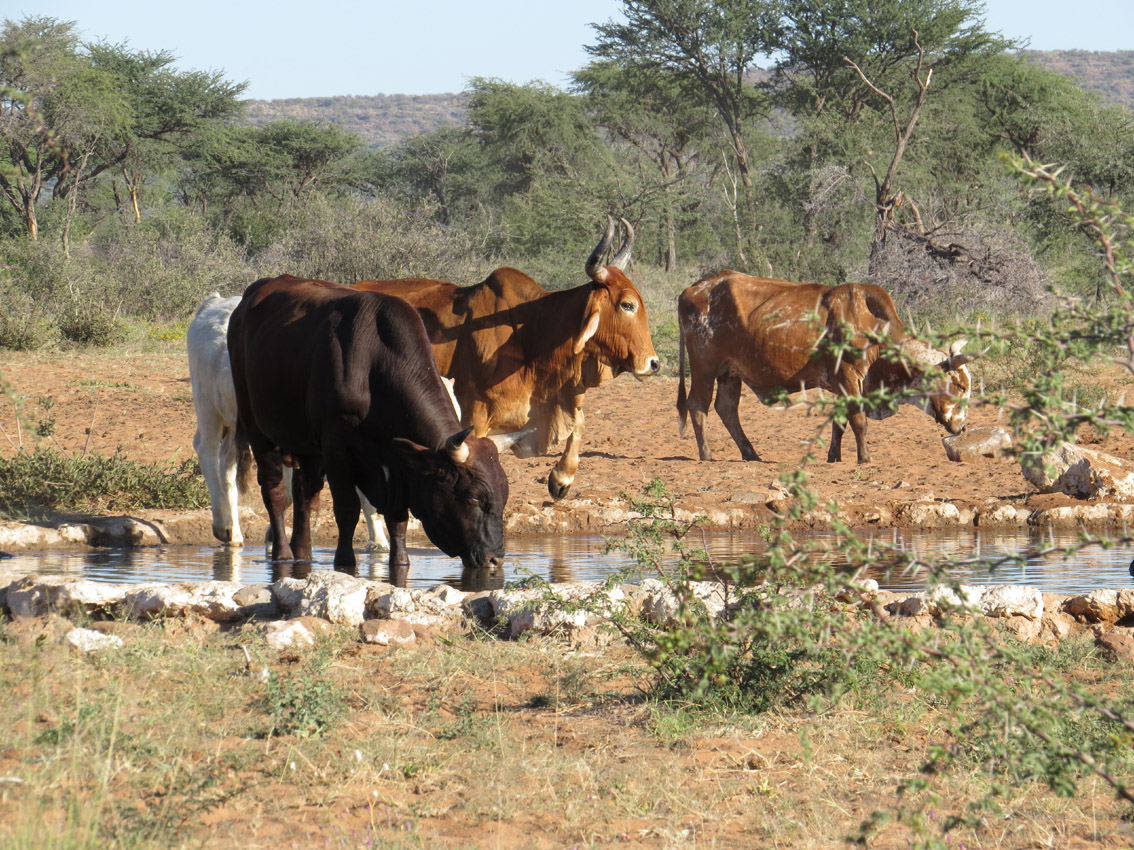
40. Cow herd.
Cows are first animals running to the water post when they hear the noise of the pump, filling the pool. After the cows, various wild animals come to drink water.
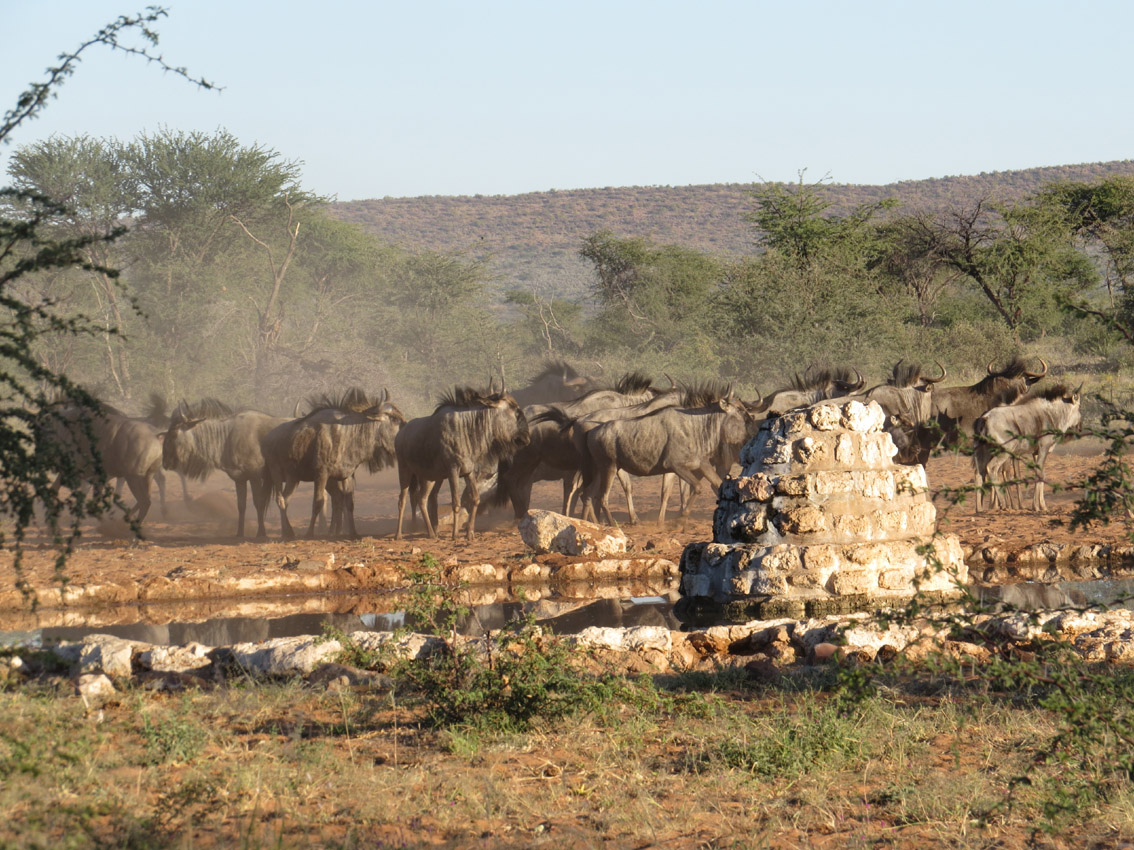
41. The herd of black-tailed gnu.
Cows leave the water post and the herd of black-tailed gnu comes to the pool.
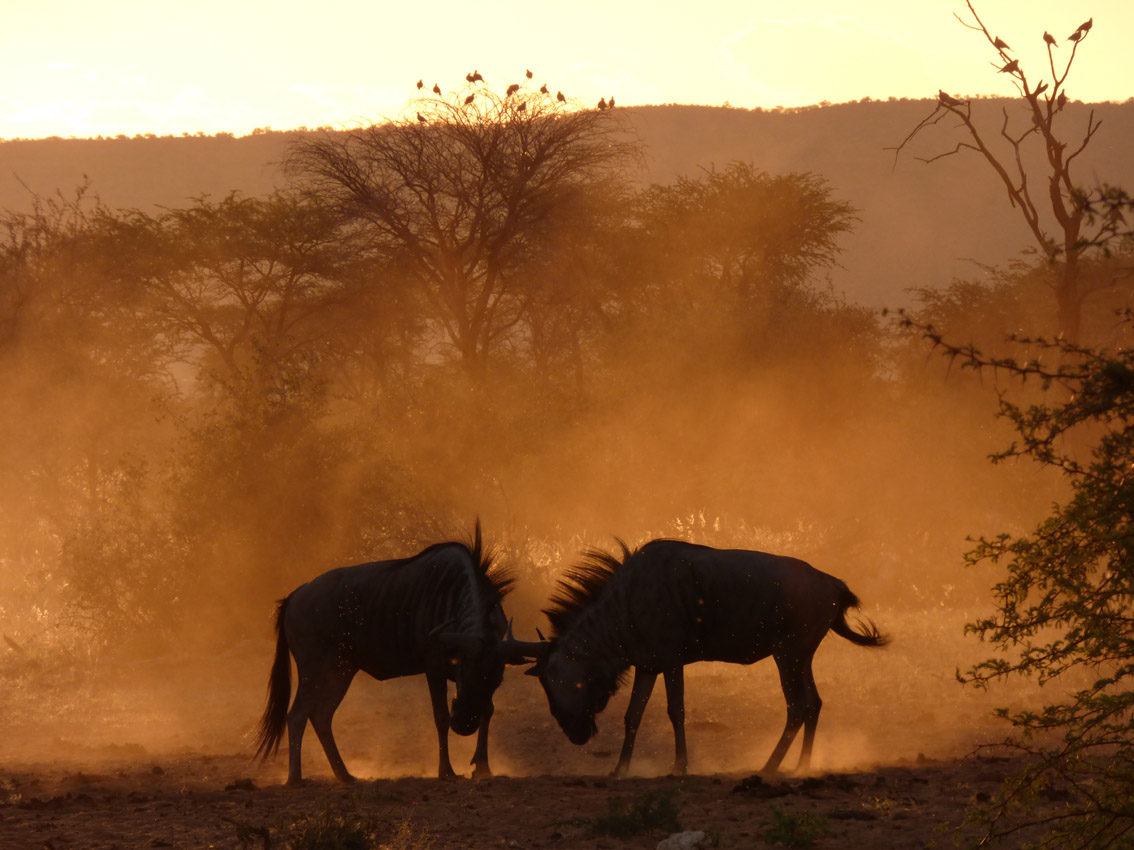
42. The black-tailed gnu in the golden dust.
After drinking the water that still remained in the pool after the cows, the gnu start playing. They raise clouds of golden dust, in which they are hardly visible.
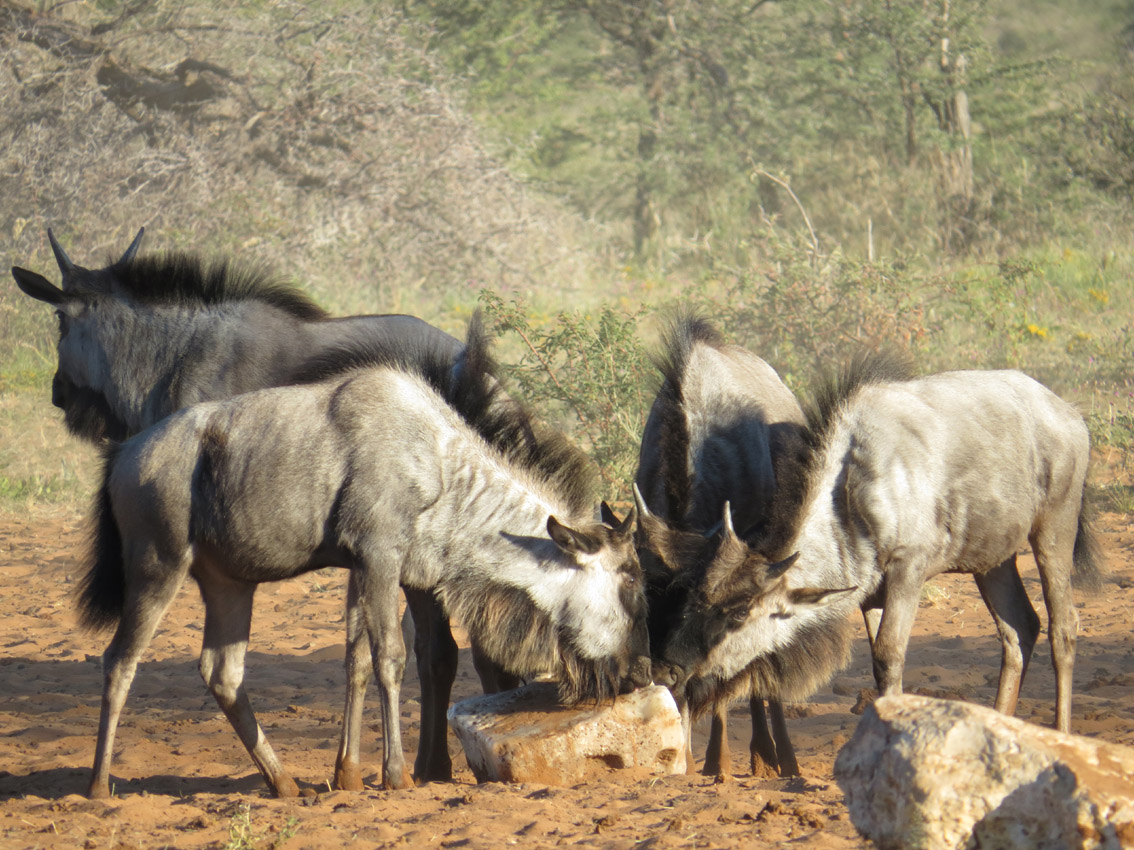
43. The black-tailed gnu licking the salty stone.
Many farmed ungulates need in supplementary minerals. As the source of salt, they receive large industrially-produced salty stones. We could observe many dozen impala concentrating in places where the natural sources of minerals are available to lick the earth and natural stones. Probably, impala need other minerals besides the common cooking salt.
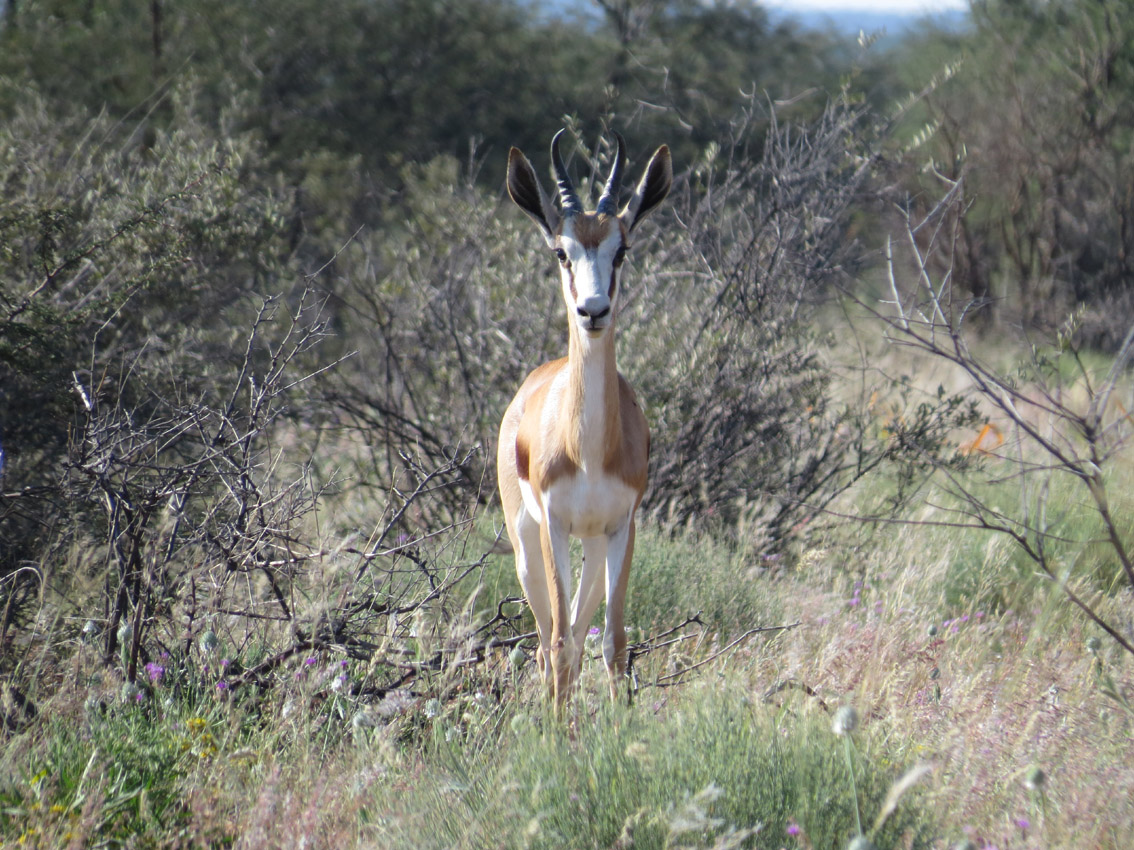
44. Male springbok antelope.
As impala, springboks are famous with their fantastic vertical leaps up to few meters. Impala commonly escape people, so this close-distance photo is a good luck.
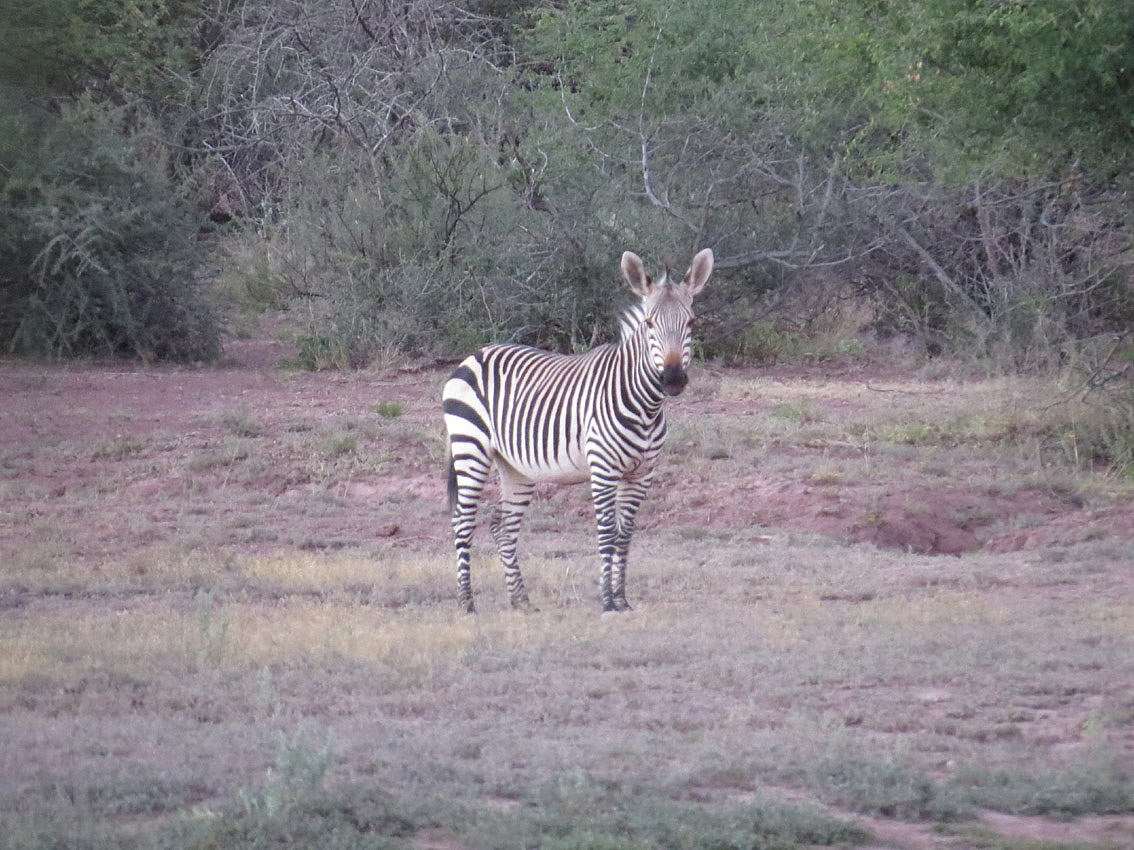
45. Mountain zebra.
There are two zebra species on the farm: the mountain zebra and the plain zebra. They can be distinguished by their coloration. The plain zebras have brown bands in between the black and white ones, whereas the mountain zebras have not.
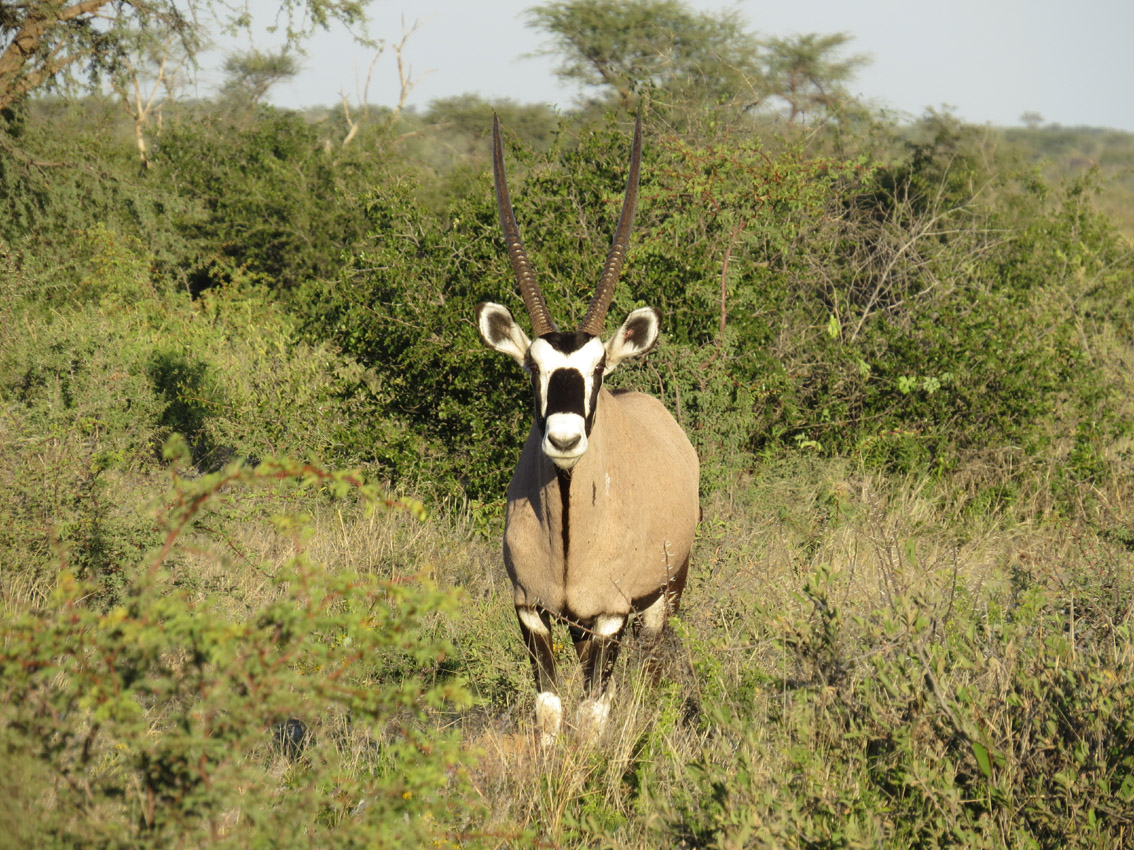
46. The Oryx antelope.
The Oryx antelopes are famous with their tremendous straight horns, used for the ritual fights during the rut.
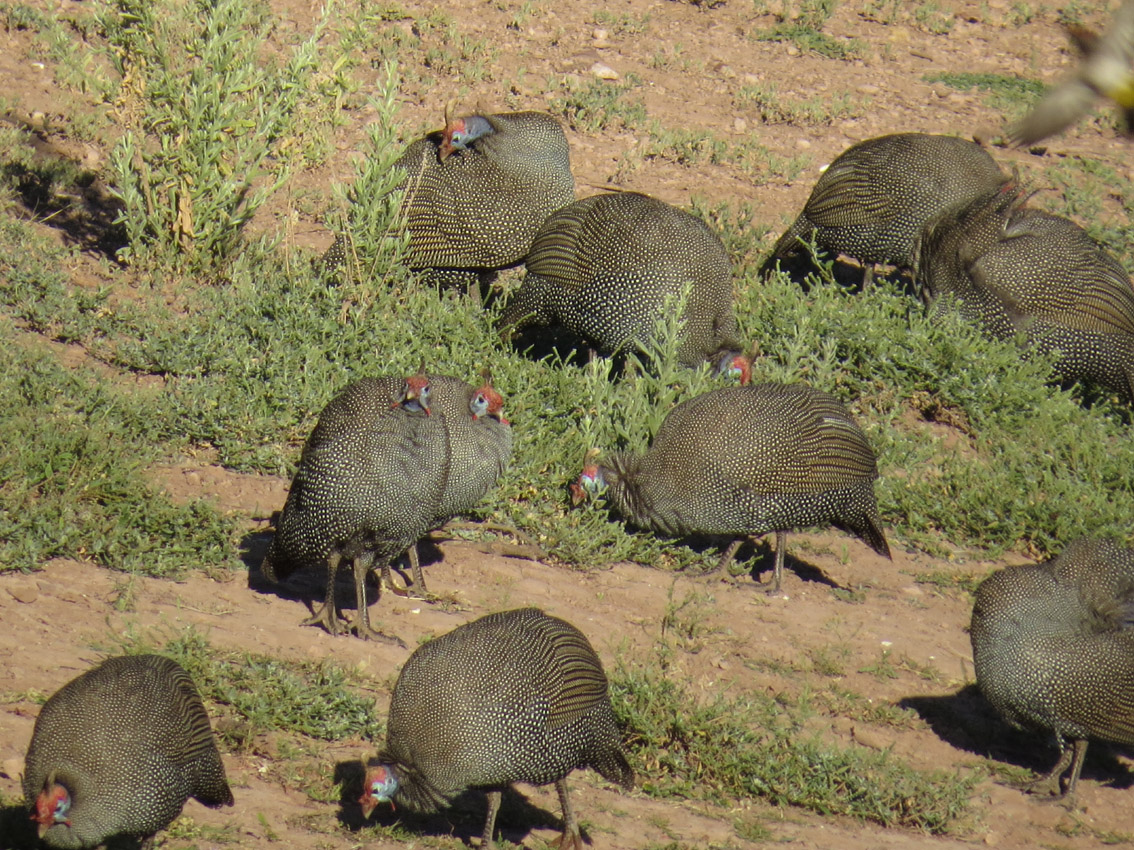
47. The Guinea fowl.
The Guinea fowl make an every-morning deed, by leaping down from the tree where they spent the night and crossing the open place to their feeding grounds. The hides for observing impala should not be under such tree, because the alert Guinea fowl will make a terrible noise, unmasking the researcher to every animal around a kilometer.
Calls of the Guinea fowl flock, crossing on foot an open place: Numida_meliagris3_flock.wav
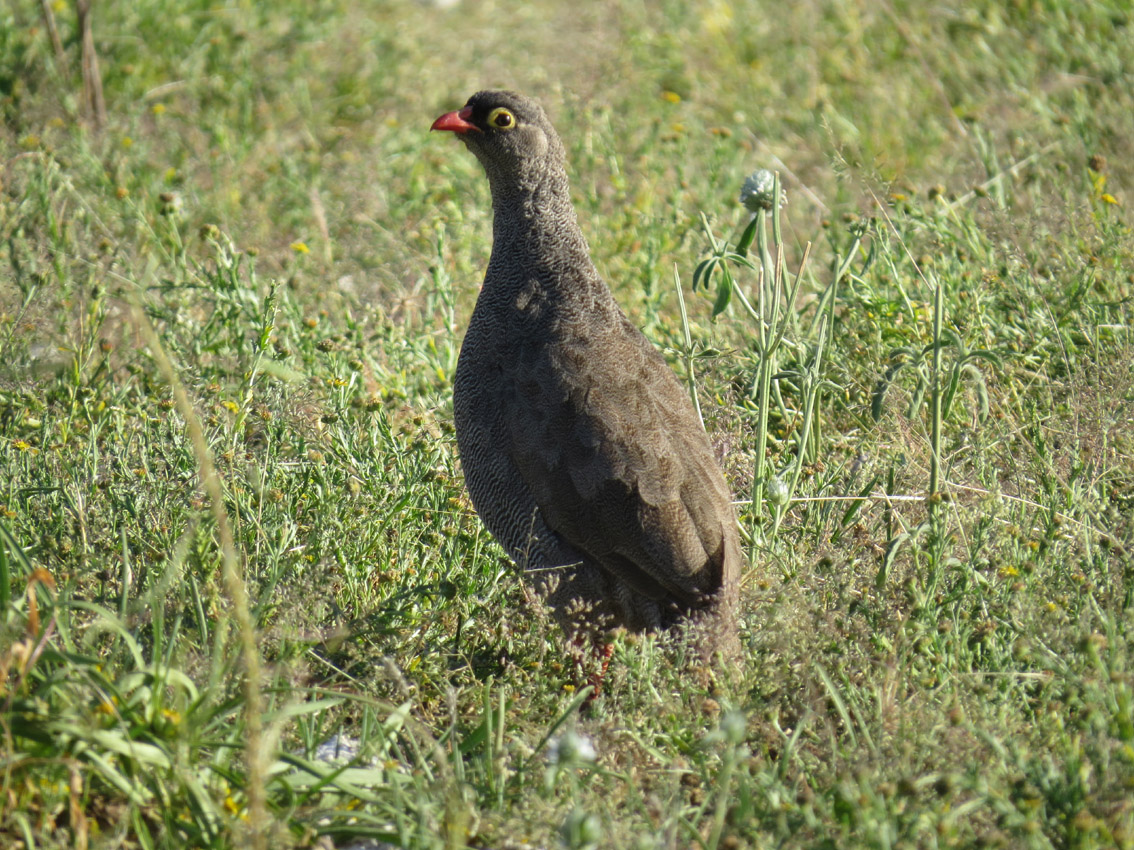
48. The red-billed francolin.
The red-billed francolin is another very common bird walking on the earth. These birds are less loud and clamorous compared to the Guinea fowl, so they are less “dangerous” for the researchers, observing impala from the hide.
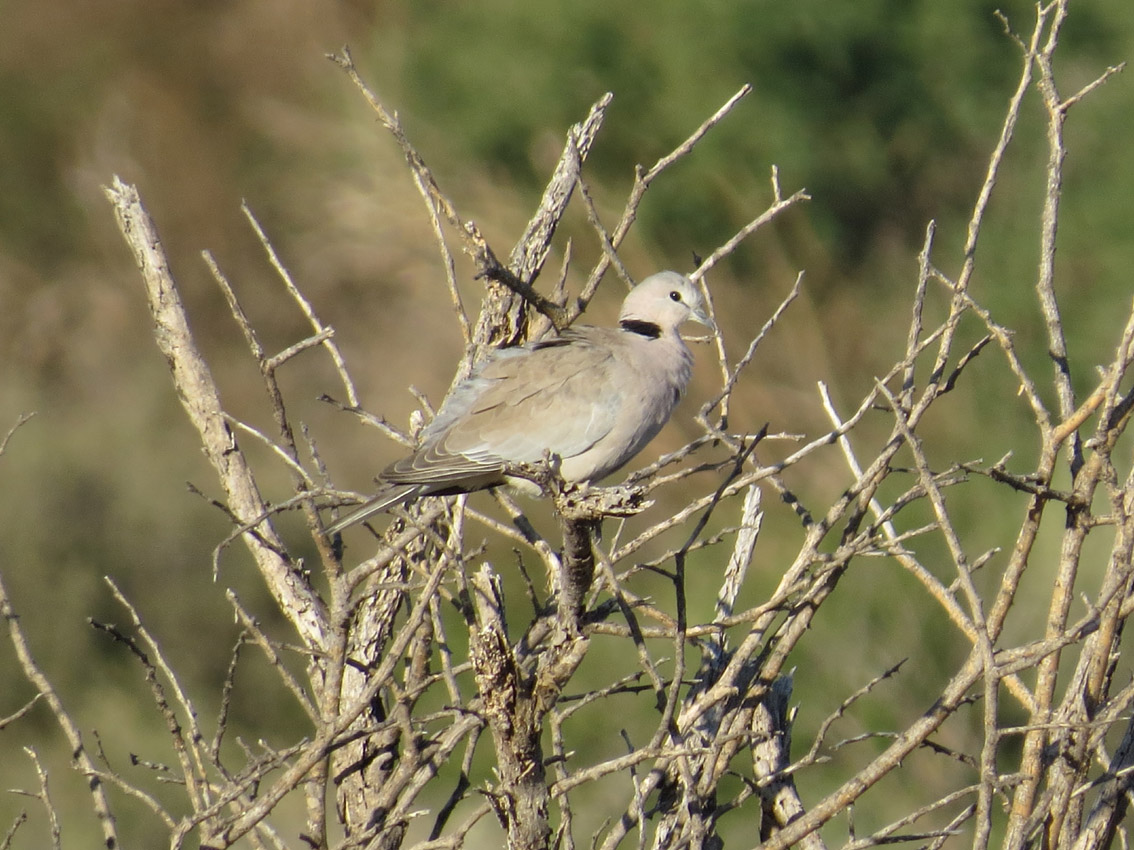
49. The Ring-necked dove.
The ring-necked doves are most interfering for the impala acoustic recordings. Probably only the wind is worthier. However the wind blows and stops. The Guinea foul vocalize and flee. But the ring-necked doves vocalize permanently day and night, morning and evening. The frequency range of their calls overlaps with impala rutting calls and the doves call even louder than impala. So their calls cannot be filtered out from the recordings of impala.
The ring-necked dove endless cooing: Streptopelia_capicola1_cooing.wav
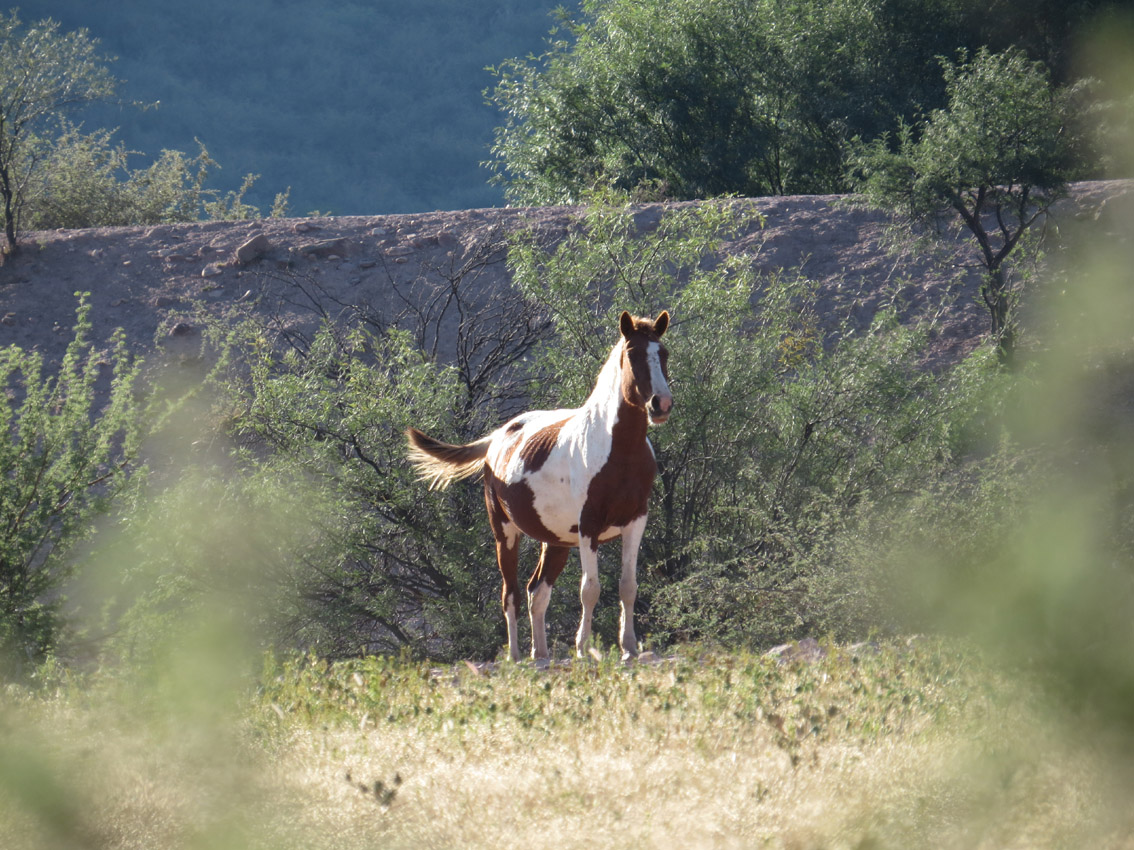
50. The domestic horse stallion.
Most interfering mammals are horses, walking unrestricted in small groups. The day when the horses detect the researcher is lost for observations. The horses will not leave and will demonstrate various complains, by stepping from leg to leg, snorting, walking around the observer, gazing. Or freeze on the place, displaying the apparent fear although really they do not afraid of people at all.
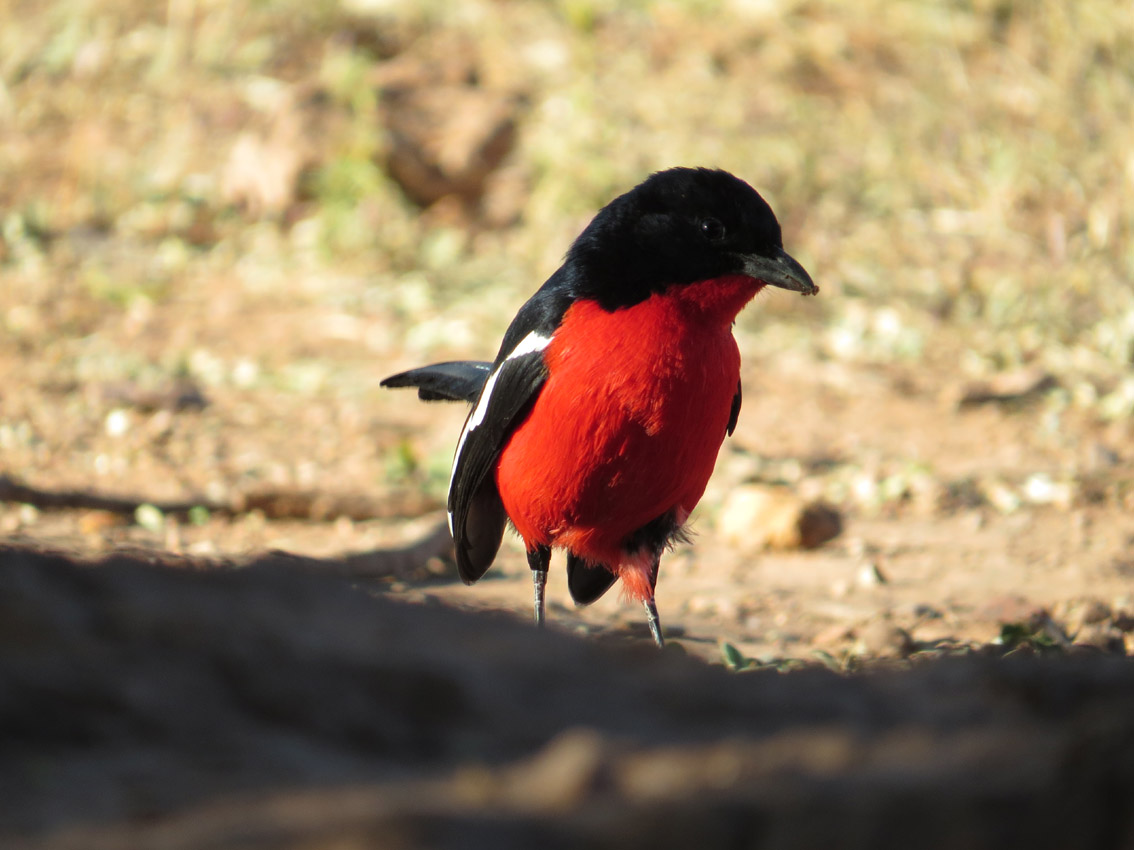
51. The crimson-breasted shrike.
This fairly colored bird is the relative of the great grey shrike. There are no troubles for the researchers from the side of these birds. They entertain researcher during observations, if impala do not come too long.
Various loud calls of the Crimson-breasted shrike. Laniarius_atrococcineus1_calls.wav
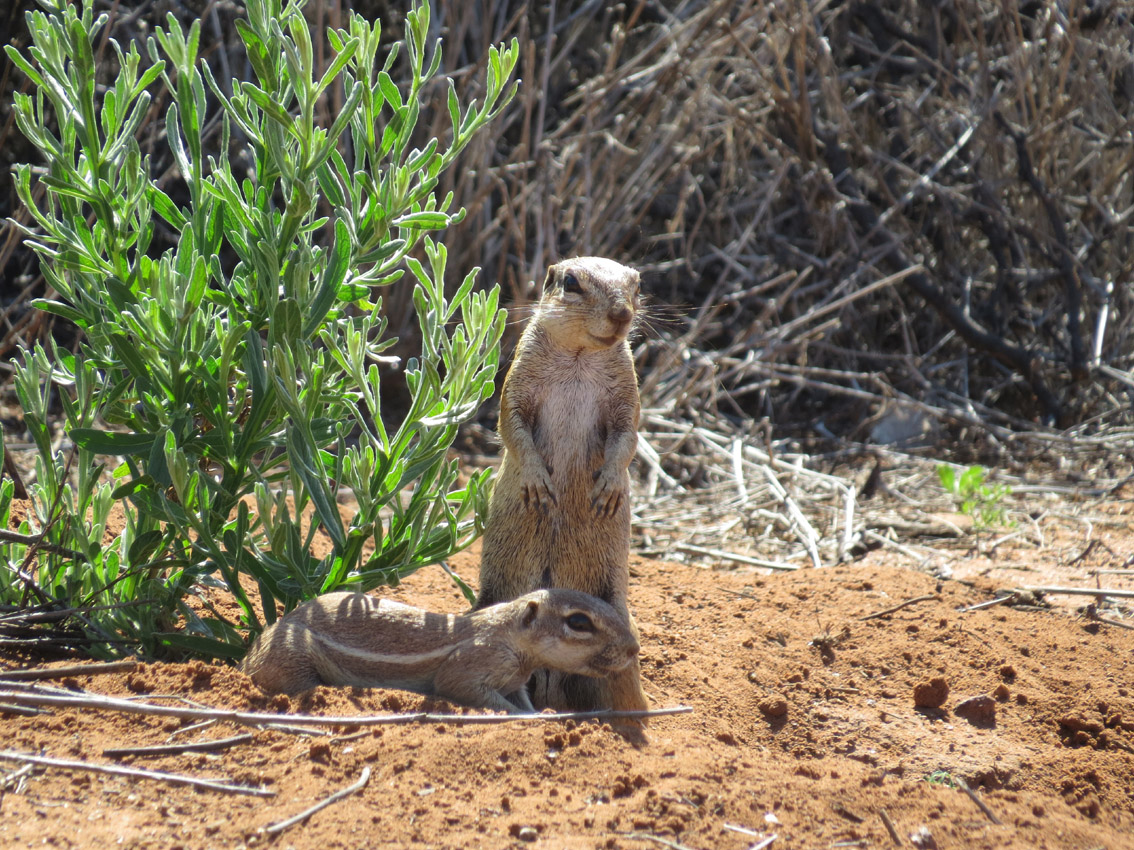
52. The Cape ground squirrel.
The Cape ground squirrels are active in the morning and in the evening, and also entertain the observers during their waiting for impala.
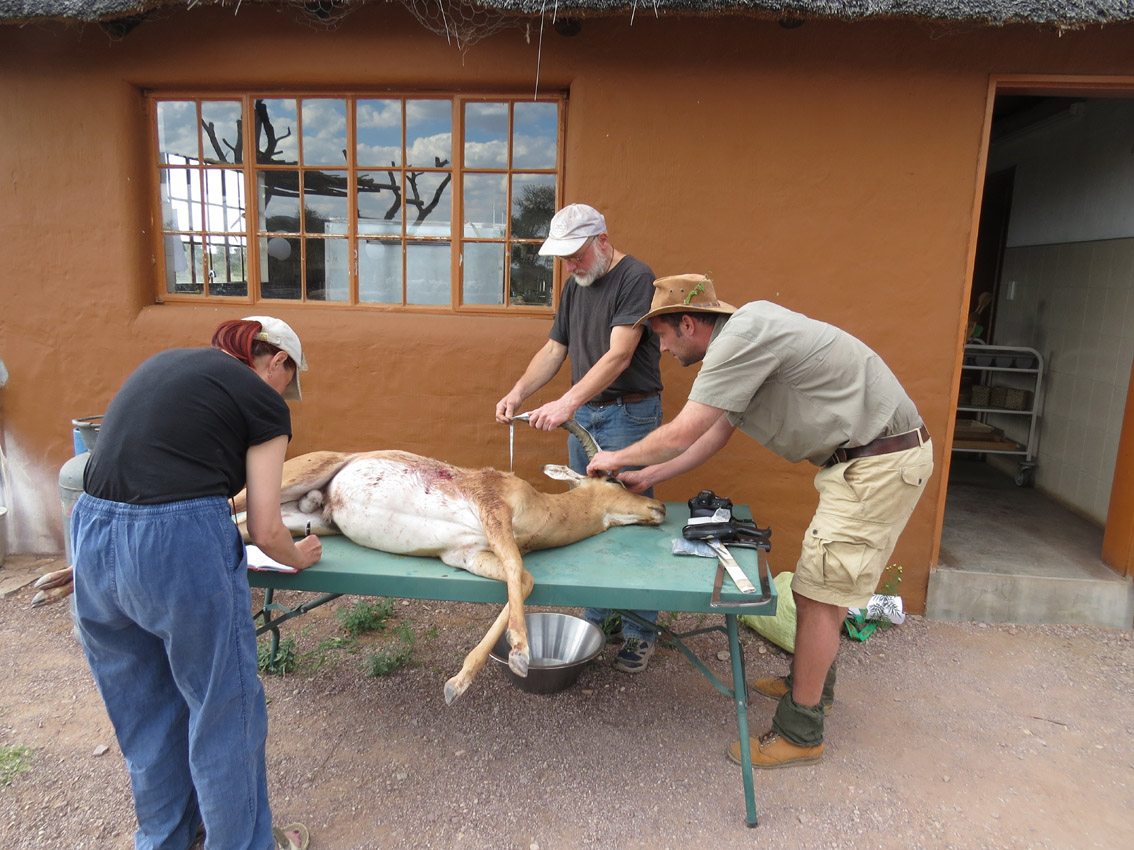
53. Male impala measurements.
To avoid overgrazing leading to habitat degradation and mass death of animals because they are too numerous, some animals are shot for food for tourists as well as for trophies. At preparing the trophies, the vocal apparatus and head tissues are damaged very strongly and cannot be used for research purposes. But this broken-horned male impala is not appropriate for the trophy, so we could use its head and neck for anatomical investigations. The non-broken horn is measured to know its length in an adult male. Then the horns will be sawed out, to not interfere during the detailed anatomical investigation, which will take four days. Nevertheless, this is only express-investigation. The “normal-length” investigation takes a month using a specimen immersed in icy water. The cool water is good for the specimen that by this way is better preserved, as well as for the researchers for supporting their enthusiasm. Further anatomical dissections will be done using the specimens brought to Berlin from European zoos, where impala died from natural reasons.
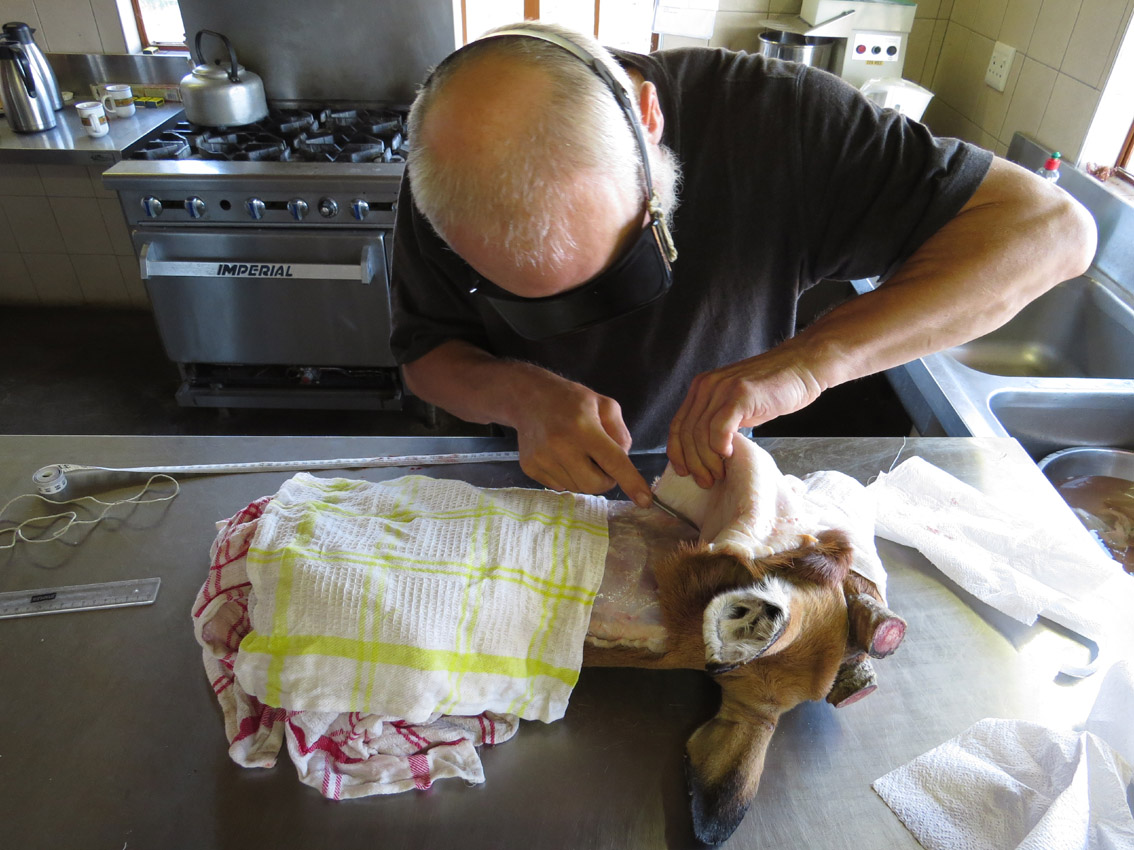
54. The anatomic investigation.
Numerous head and neck muscles will be dissected one by one. After that, measurements of cartilages of the vocal apparatus and vocal folds, responsible for producing the impala rutting calls, will be taken. All the measurements will be listed in a detailed protocol to the computer. All the sequential stages of the dissection should be documented with two photo cameras, to have the double data for the case if one of the memory cards is damaged. Natural lighting is very important for either dissection or taking photos. So, we get up still in full darkness, in order to use all the light day from dusk to down.
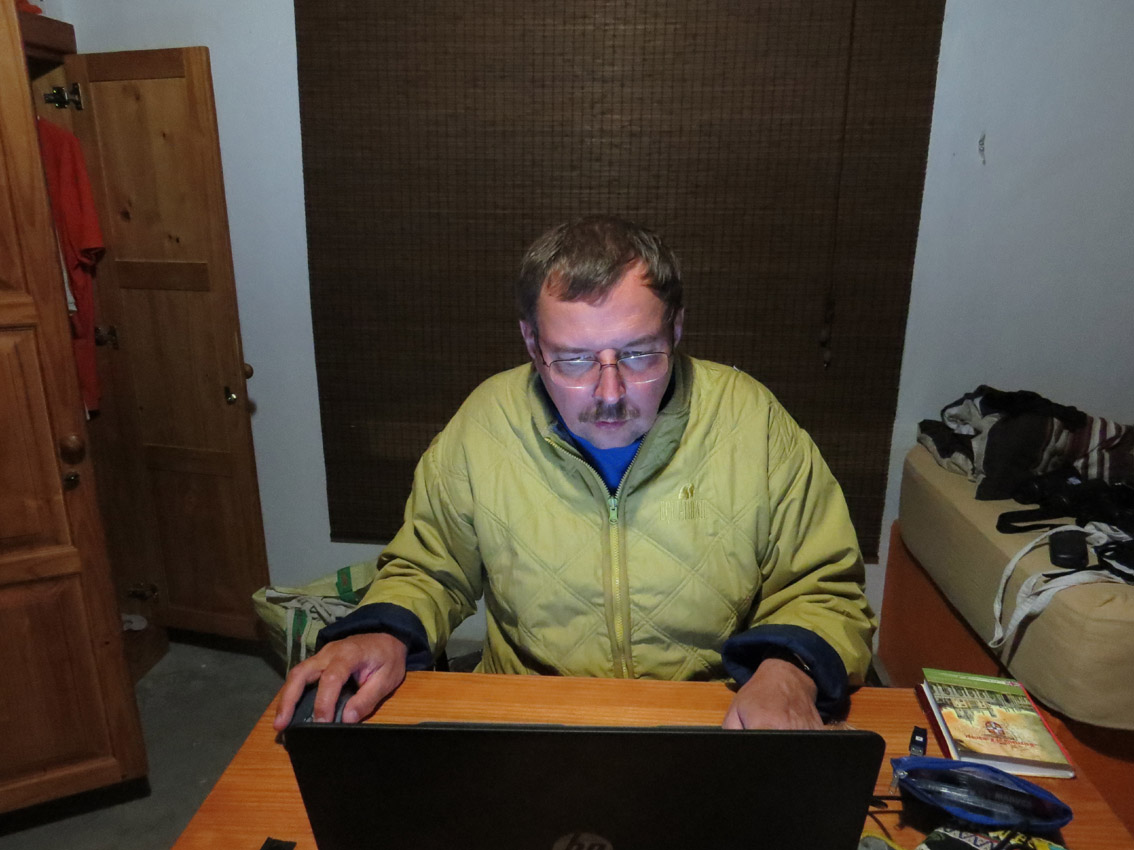
55. The computer work.
The computer work is the very important component of any research. During the peak of the rut, male impala vocalize for nearly 24 hours. The stationary units, working automatically in the absence of researchers (songmeters and photo traps) provide a tremendous massive of recordings each day. This massive should be systematized and estimated by quality, in order to change the settings of recordings when necessary. All materials should be copied, because the loss of an unique data exemplar is the top non-professionalism. The computer work takes nearly all time free of observations. So, the chronicle deficit of sleep in expedition is practically unavoidable. And this is only preliminary work! The acoustical analysis of data will need much more time, and also statistical analyses, writing and publishing scientific papers…
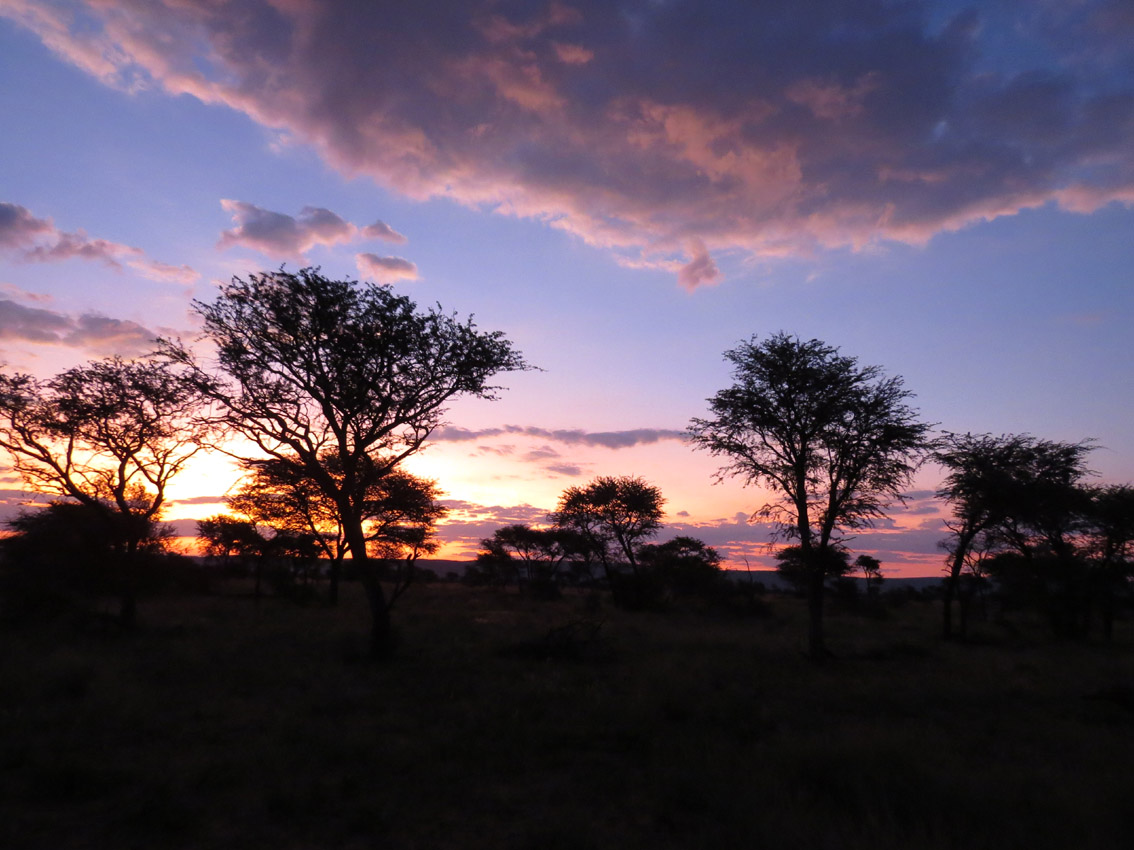
56. The departure.
We depart next morning. All the best, Africa! The impala rut was very active, so many offspring is expected to be born. In 6-7 months we will try to be back for recording calls of mother and young impala.
|



